I took my dog to Barcelona to get an EU pet passport: Here's what I learned
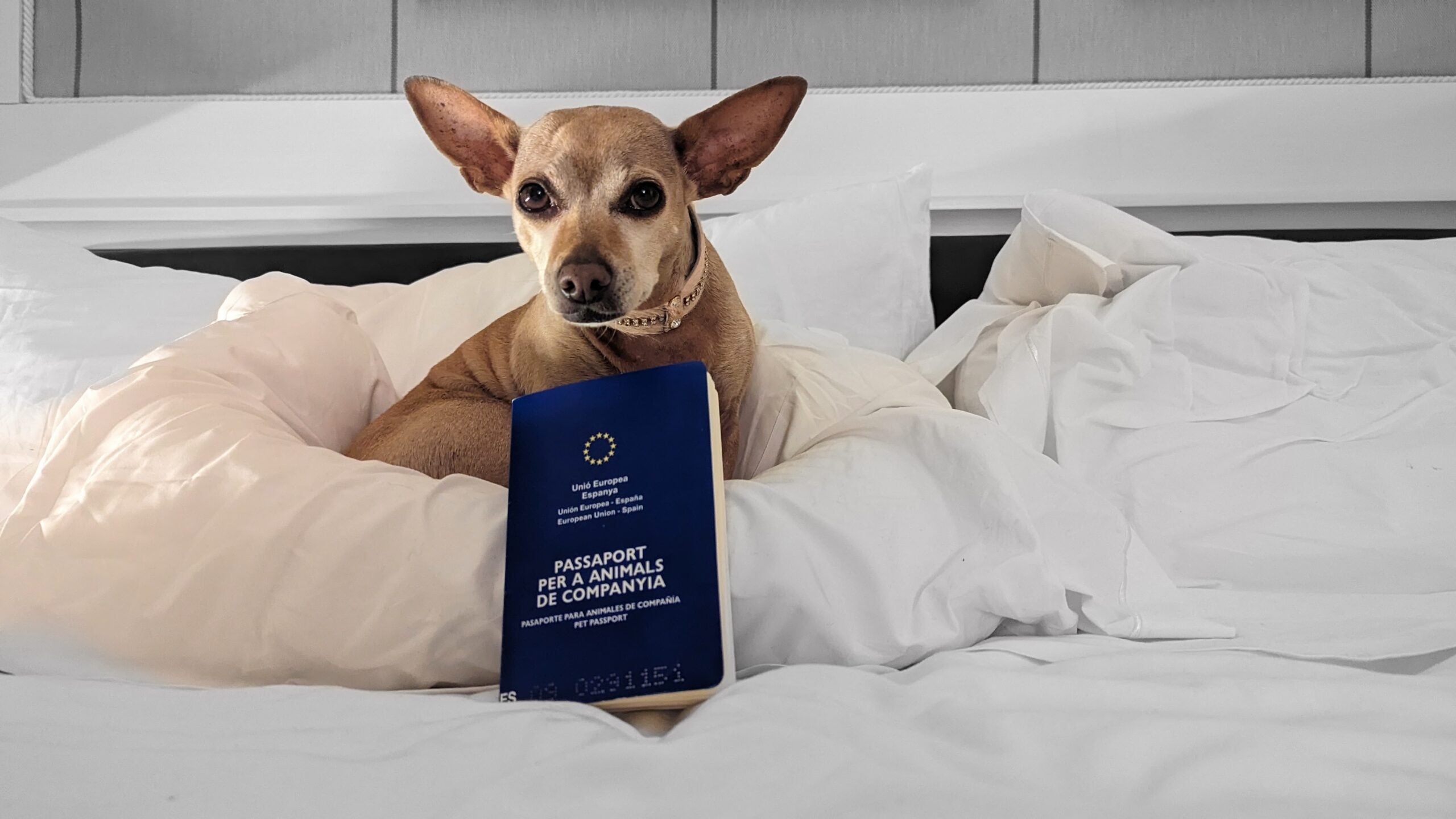
In 2023, my dog Poppy flew United Airlines 37 times, vacationed in Aruba and Mexico , and, most exciting of all, got her European Union pet passport in Barcelona.
Poppy, who is trained to assist me with a psychiatric disability, flies free as my service animal . However, we were spending a small fortune each year on international health certificates (around $300 per certificate) required each time an American dog enters any country other than Mexico and Canada.
Having an EU pet passport eliminates this step and allows Poppy to travel freely to EU countries — as well as Switzerland, Norway and much of the Balkans — for the next three years. This is a great cost-cutting measure for travelers who frequently visit Europe with a pet.
Getting an EU passport for Poppy in Spain was much easier than I expected. As I learned, Barcelona is the perfect destination to go through the process.
Pups are everywhere in this city, and it's hard to walk for more than a minute without your doggo sharing sniffs with another canine. There are also fantastic dog-friendly hotels , restaurants, Europe's only dog water park, beaches and even some attractions you can visit with your fur child.
Here's everything you need to know about the EU pet passport process. Note this article pertains to American dogs traveling to and from the EU. Every country has different entry requirements. So, if your dog doesn't live in the U.S., you'll need to check with your home country about the requirements if you plan to travel back and forth.

What is an EU pet passport?
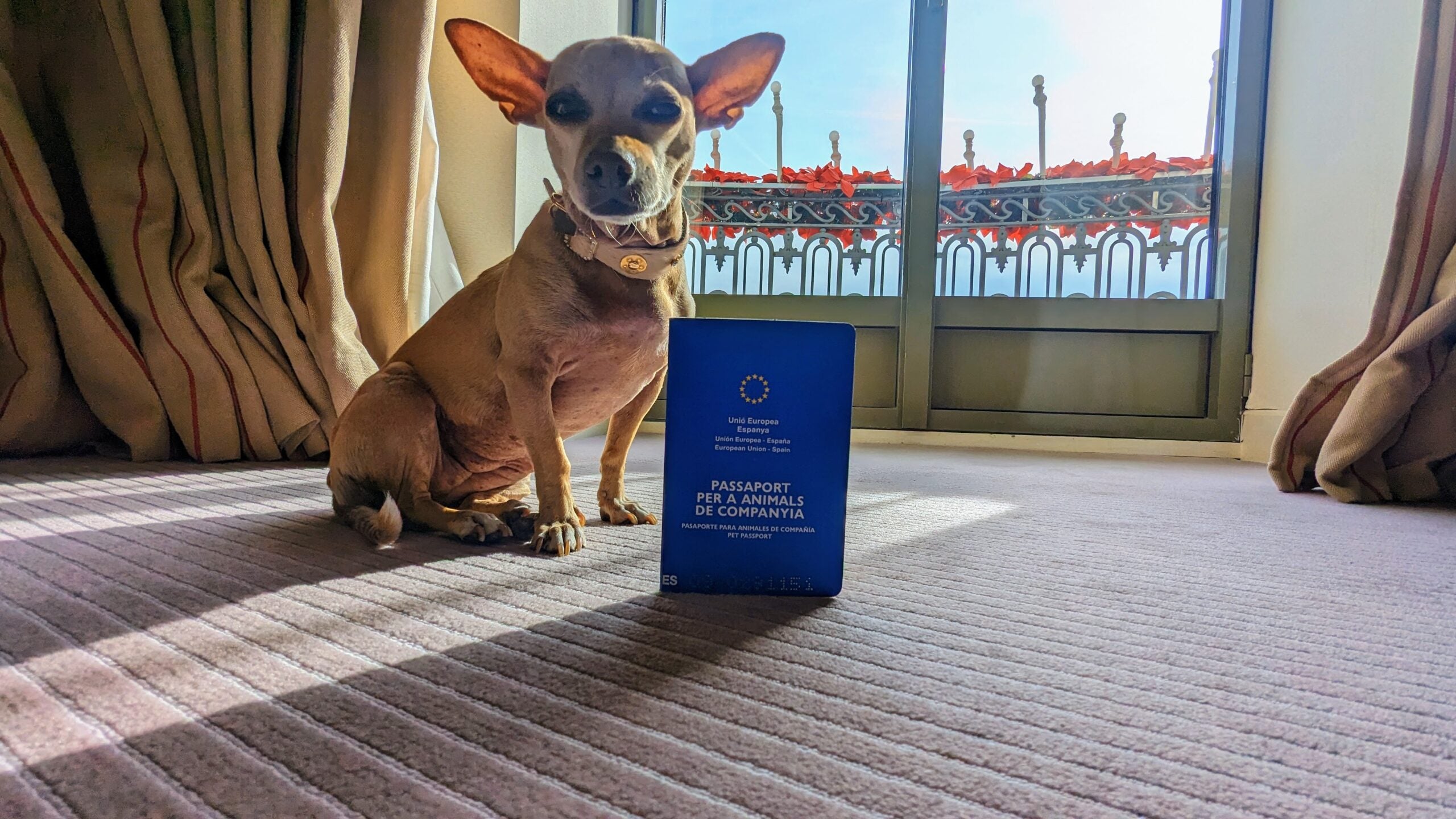
An EU Pet Passport is a document issued by an official veterinarian in a country within the EU that contains health information related to a specific pet. It cannot be obtained in the U.S. The passport is a blue booklet that resembles a human EU passport and even has space for a photo of your pup (though this is not mandatory).
What is mandatory is that your dog be revaccinated for rabies by the EU veterinarian that issues the passport. So, you must take your dog to Europe to get vaccinated. The trickiest part of this process is that your dog must be vaccinated against rabies twice if you are traveling to Europe and not moving there. This is because to return to the U.S., you will need a valid rabies certificate issued by an accredited American veterinarian. Think of it this way: A rabies vaccine basically serves as your pup's passport, so they will be dual citizens.
"Luckily, there are no proven negative effects of double vaccinating a dog against rabies, so long as the vaccines are not given within a few months of each other," Poppy's veterinarian, Dr. Bethany Yurek, who practices in Colorado, told me. Poppy's vaccines are spread out 1.5 years apart, which resulted from lucky timing, but if the vaccines are given about six months apart, you should be good to go.
Of course, it is always best to consult your veterinarian before deciding to revaccinate before expiration. You will also want to request three-year rabies vaccines.
Why get an EU pet passport?
If you plan to travel to Europe multiple times over three years (the length of the longest rabies vaccine), an EU pet passport will save you thousands of dollars and a lot of time.
Without one, you will have to take your dog to its veterinarian to get an EU international health certificate issued and then endorsed by a vet at the U.S. Department of Agriculture. The entire process must be done within 10 days of entering the EU, and it'll cost around $300.
You can use your health certificate to enter multiple EU countries for up to three months on a single visit, but you cannot use the health certificate for a second visit later. So, even though I got a health certificate when I took Poppy to Italy previously, it was not valid for this trip to Spain.
Obtaining an EU pet passport (besides being adorable looking) allows you to travel back and forth to EU countries, Switzerland, Norway and much of the Balkans without any other paperwork for as long as the EU-issued rabies vaccine is valid.
To maintain your dog's EU passport, you must schedule their next rabies vaccine in Europe before it expires.
Can dogs living outside the EU get the pet passport?
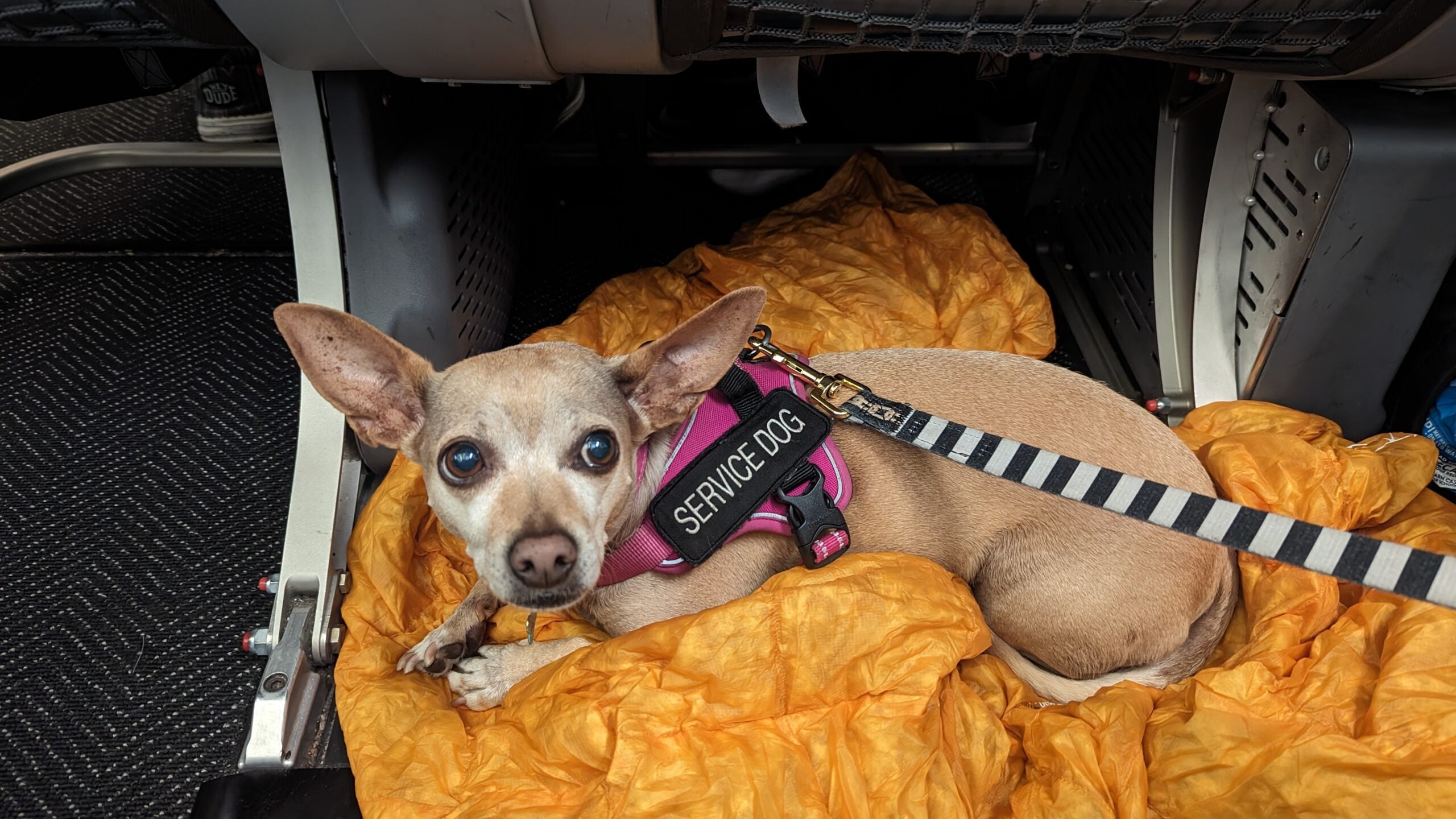
Yes. "The purpose of the EU Pet Passport is to simplify travel between EU Member States, but the EU has also allowed it to be used for pets returning to the EU from other countries as long as it is a non-commercial movement," according to the USDA. Noncommercial movement means you are not importing more than five animals to sell them. The passport is designed for pets only.
What is the process for getting an EU pet passport?
Getting an EU pet passport was a lot easier than I expected. I used TomVets in Barcelona; I found the company by quickly searching Google for vets with good reviews issuing EU pet passports to visitors. I reached out via WhatsApp and received a response in English within a day.
Dr. Tommaso Piermarini makes home vet visits. He came directly to the Majestic Hotel & Spa , where we were staying, to administer the rabies vaccine and issue the passport. It was so convenient that it immediately brought my stress levels down. I filled out some quick paperwork online before the visit, and that was it.
On the appointment day, Dr. Tommaso showed up promptly and spoke fluent English. We went to my room, and the process took less than 30 minutes. When he left, Poppy had a shiny new passport. The cost was also very reasonable at 155 euros ($167).
Barcelona is ideal for a Spanish citizenship vacation

Besides the ease of getting the EU pet passport here with a mobile veterinary service like TomVets, Barcelona is a fantastic doggy vacation destination. In addition to its Mediterranean climate, great food and beautiful beaches, the city welcomes pups with exuberance.
I stayed at the Majestic Hotel & Spa , an elegant neoclassical property on the city's famous shopping street, Passeig de Gracia, in the trendy Eixample neighborhood. Welcoming guests since 1918, it's the city's most famed luxury hotel.
The Majestic welcomes small canine guests with its Very Important Pet package ; the package includes a personalized welcome card, toys, treats, bottled water, a comfortable bed, food and water bowls to use during your stay. Dogs must weigh about 20 pounds or less — the same size pup that can travel as a pet in airplane cabins.
The hotel has various accommodation options, but in honor of Poppy's Spanish citizenship milestone, we stayed in one of the Majestic Suites. The massive room featured multiple balconies offering jaw-dropping, panoramic city views; a separate bedroom and living space; a giant walk-in closet; and a marble bathroom.
Don't skip sunset drinks and a bite to eat at the Majestic's rooftop terrace bar — where you can, of course, bring your pup. The 360-degree views of the city serve as the perfect backdrop for a photo sesh with your best friend. The sunsets seem to go on forever with an everchanging display of vibrant colors.
The hotel also has a fantastic spa, and I got rid of my jet lag with a luxe two-hour body and facial treatment.
Dog-friendly attractions and restaurants

Across the street from the Majestic is Casa Batllo . Considered one of Spanish architect Antoni Gaudi's greatest masterpieces, it was created in the early 1900s for a wealthy family. Nowadays, it is an immersive architectural museum experience and one of the few attractions of its kind that welcomes dogs. Poppy swapped tea with more than one canine visitor while I got lost in its trippy light shows, shimmering tile facade, undulating curves and other swirling shapes. If you visit during summer, Casa Batllo often has live music and drinks on its roof terrace.
The Majestic's central location makes it easy to access some of Barcelona's best neighborhoods for walking. The Gothic Quarter and the Born are within a 30-minute walk of the hotel. Most shops in Barcelona allow dogs, and many restaurants also welcome pets on their patios. Some places — like La Carioca , which serves Brazilian-inspired food and drinks — even include pups inside.
Related: 10 best dog-friendly destinations to explore this summer
Barcelona is also home to Europe's first water park for dogs. AquaPark Canino is a must for pups who like to swim. The park, open from June through September, has two large swimming pools, a dune area for rolling, gardens for frisbee or ball-catching sessions, and even a restaurant where you and your pup can dine.
In winter, you can walk your dog along Barcelona's beachfront and miles of gold sand. However, in summer, you'll need to stick to Llevant Beach, Playa de Les Salines and Cala Vallcarca, which are dog-friendly.
The city also has several dog-friendly parks and gardens, including most parts of Park Guell , another Gaudi-designed masterpiece. Parc de la Ciutadella, Parc del Clot, Parc de la Barceloneta and Joan Miro Park also welcome woofers.
Finally, if your pup likes to shop, you must head to Barcelona Dogs in the Born. The shop carries one-of-a-kind designer collars and matching leashes as well as harnesses and coats for dogs and cats. Poppy chose a beautiful pink suede collar adorned with filigree crystals to celebrate her Spanish citizenship.
Related reading:
- Key travel tips you need to know — whether you're a beginner or expert traveler
- The best travel credit cards
- Where to go in 2024: The 16 best places to travel
- 6 real-life strategies you can use when your flight is canceled or delayed
- 8 of the best credit cards for general travel purchases
- 13 must-have items the TPG team can't travel without

Ultimate Guide: Bringing Your Dog to Europe from US in 2024
- August 3, 2023
- Dog Travel Tips , Europe Pet Friendly Guides , Uncategorized

You can bring your dog to Europe from the US in 2024. It’s easier in 2024 than before but it still requires careful preparation and adherence to each European country’s specific regulations . Generally, you will need a valid pet microchip for identification, up-to-date vaccinations (including rabies), and a pet health certificate from a veterinarian. Some countries may also impose quarantine periods or have breed-specific restrictions but that is very rare.
Additionally, you must check with your chosen airline for their pet travel policies and fees. By meeting all the necessary requirements, you can ensure a smooth and enjoyable journey for both you and your furry companion.
Disclaimer: All views and opinions expressed in this blog article are our own and do not necessarily reflect the views or positions of any entities they represent.

How to Bring Your Dog to Europe From US
Step 1: you must decide where you want to go (which european country) and when.
The first thing is deciding where to go and when. This, we believe, is the first step because it determines the rest of how you plan and go about obtaining the required documents.
If you decide to go to Europe during the off-season (November – March), then plane tickets and accommodations will be much more affordable than during high season (late May – August). Shoulder season (April – mid June; late September – October) would be a great in-between option in terms of prices and crowds.
As a general rule of thumb, you should give yourself at least 3 months of planning before you leave for Europe with your dog.
Once you choose the country you plan on going to and when, then you can move onto the next step…
Step 2: Book a vet appointment as soon as possible
First, it is mandatory that your pet is microchipped and has their up to date vaccinations in order to travel to Europe. Please double check with your vet about this before booking any appointments. Note that previous vaccinations won’t be valid if given before the microchip.
After ensuring your pet is microchipped and has the necessary vaccines you will need to book an appointment with an accredited vet who can issue you an USDA-endorsed pet health certificate . Not all vets are able to do this. We recommend calling your vet’s office first and confirming before booking an appointment. You can also search this database as well to find an accredited vet.
Below is a script you can use when calling the vet:
“Hello, I plan on traveling to [European Country] on [Date you plan on traveling] and need a pet health certificate done for my pet. Does your office have any vets that are accredited and able to issue this for me?”
To clarify, an USDA-endorsed pet health certificate is a document that is given to you and your pet from a vet, after the vet has deemed your pet healthy enough for travel. You will need the hard copy of this form, embossed and signed by the USDA endorsement office when you fly. Meaning this document can not be shown electronically through your phone or computer. When you are checking into your flight, the airline will required the hard copy of this document. You may also need to show this document upon arrival at your designated country as well.
It is also important to note that if you do not have an European Union pet passport for your dog or pet then you will need to visit the vet and get your pet health certificate done within 10 days of your departure date (your flight date).
More Information About the USDA-Endorsed Pet Health Certificate
To meet your designated country’s requirements for an USDA-endorsed pet health certificate you must obtain this from an accredited veterinarian. They will assist in completing, signing, and dating the necessary certificate. Your veterinarian can then submit the certificate directly to the USDA Endorsement Office through the Veterinary Export Health Certification System (VEHCS) or provide you with the paperwork for you to submit to the office yourself. The USDA Endorsement office will then emboss and sign the hard copy and send it back directly to you so you can bring it to the airport. Please note that you will have to pay for shipping.

Step 3: Book your flight and check airline requirements
Next is making sure you book flights for you and your pet! This step can be done simultaneously with Step 2; however we find that if you get your vet appointment date booked and figure out all that business with the USDA-endorsed pet health certificate then booking your flight becomes more seamless.
We are based in California so flying into a major European city such as Paris, Milan, etc would be the most efficient because they tend to have direct flights. We flew French Bee and loved it! Very straight to the point, cost efficient and we have not experience any delays or cancellations with them.
We listed below the airlines you can bring your dog and fly in cabin with them to Europe from US in 2023. You can click on the links to each airline to be taken directly to their pet policy page.
- Aegean Airlines
- TAP Air Portugal (We do not recommend flying with them. We experienced a lot of issues with this airline.)
- United Airlines
It is also important to note that you will need to buy a soft carrier for your pet if you plan on traveling in cabin with them. We rated the top 5 best dog carriers for 2023 here if you want to check that out!
We recommend you review your airline’s pet policy in detail and understand the following:
- their maximum weight allotment (usually has to be under 17-22 pounds, including the carrier)
- their maximum carrier size & carrier requirements
- the cost to fly your pet in cabin with you
- if there are any additional paperwork needed to check your dog into the flight
Step 4: Ensure your pet and you are ready for travel
Lastly, once everything is squared away you can relax! Well, sort of. We recommend you train your pet for airline travel. Getting your pet used to the carrier, making sure they relieve themselves before the flight, and watching their food and water intake are all things you must do to ensure a smooth journey.
If you want a free guide on how to best prepare your dog for in cabin airplane travel then just sign up to our newsletter below & get it instantly.
Email Address*
First Name*

Frequently Asked Questions (FAQ)
How can i take my dog to europe from the us without flying.
In 2023, flying to Europe from the US is one of the fastest ways to travel with your pet. However, there are other options if you prefer not to fly.
Ferry travel with pets is available on many large ships in US and Europe. You can sail for several hours or even days, with accommodations for both you and your pet. The ferries make stops in various countries during the journey.
You also have the option to charter a private yacht as well — but we believe this to be unnecessary and extremely pricey.
Can you bring a dog on a plane to Europe from US?
Yes! You can bring a dog on a plane to Europe. We’ve listed the airlines that allow in cabin pets to fly with their owners above. However, you must meet all the requirements and have the appropriate paperwork in order to do so.
An accredited vet needs to sign the form, and then the USDA endorsement office must endorse it within 48 hours before your pet arrives in Europe. The hard copy of the form must be on hand while traveling. If your pet is just passing through the EU, you don’t need to follow this rule.
Can dogs fly in the cabin from US to Europe?
Yes! In 2023 there are plenty of options if you want to bring your dog to Europe from the US via airplane. When flying to Europe from the USA with your dog, it’s best to choose European flag-carrier airlines as they are more likely to allow pets in the cabin with you. We’ve listed the 2023 airlines that allow pets in cabin above!
How much does it cost to fly a dog internationally?
It really all depends on when you’re traveling and where you’re traveling to. However, bringing your dog on a flight in the cabin usually costs around $125 to $250. Whereas transporting them in the cargo hold can usually be well over $1,000. For international pet shipping, licensed companies usually charge between $1,000 and $6,000. We’ve heard some destinations you have to pay upwards of $10,000 to transport your pet.
How hard is it to bring a dog to Europe?
We would say it’s not hard but it takes work. Before bringing your dog, cat, or ferret to any European Union country, your pet needs to have a microchip. Note that previous vaccinations won’t be valid if given before the microchip. Even if your pet’s rabies vaccination is still valid, it must be re-vaccinated for rabies after getting the microchip. Please also double check with the official USA website here as well as the EU official website here for up to date regulations, updates and changes.
Do dogs need a passport to fly internationally to Europe?
You do not need an EU pet passport for your dog unless you are traveling in Europe with your dog for more than 90 days. However, the European Union EU dog pet passport makes it easier for your dog to travel across Europe.
How much does it cost to travel with a dog in Europe?
It depends! If you are flying into Europe with your dog from the US then it can usually cost $100-250 extra.
However, if you’re traveling around Europe when you are already in Europe then the price can be much cheaper. Sites like Omio are pet friendly and offers affordable prices for pet friendly train rides. Dogs even get to ride for free on most trains (if your pet is in a pet carrier).
Also, if you have an European Union pet passport this allows your dog, cat, or ferret to travel effortlessly within the EU and even to non-EU countries (like UK, Switzerland, Iceland, etc). We highly recommend getting a European Union pet passport for your pet!
What is the weight limit for dogs to fly in cabin?
This will vary across different airlines. So make sure you double check with each airline’s pet policy. We link each airline and their pet policy above to make it easier for you to check!
Generally, however, we have found the weight limit for dogs/pets in the cabin to be 17-22 pounds or less. This includes the carrier’s and your pet’s weight.
Do dogs have to quarantine in Europe?
Good news! Pets traveling between Europe and the US do not need to go through quarantine, so you can bring your pet to your hotel or destination right when you land. The rules are simple: ensure your pet has a rabies vaccine, a microchip, and a health certificate from a USDA vet. That’s all you need to worry about!

We hope you found this article helpful!
Travel Dog Bodhi 🐶
Did this post help you sniff out some useful info for your furry friend?
If so, don’t be shy, give us a bark in the comments section! We love hearing from our fellow dog lovers on the go.
Share this:
8 thoughts on “ultimate guide: bringing your dog to europe from us in 2024”.
Pingback: Flying with a Dog 2023 - The Dog Vacation
Pingback: 8 Unique Things You'll Do in Europe With Your Dog if You Really Love Them -
Any arliner that permits my dog coffee in cabin even if weight in at 22kg ?, i am willing to purchase additional seat to travel to stockholm, sweden , since traveling in the cargo area seems like a big misstake.
i am travelin from Nuevo Laredo and if easier i take him over to laredo Texas, help would be appreciated ..
For dogs that weigh 22kg, we believe that is over the weight limit to fly in cabin for most airlines. You may have to consider flying your dog in the cargo/hold or through private/semi private airlines.
Great article, but I do have a question about American Airlines. When I checked on their website, it said no pets in cabins on international flights from US to Europe/UK. Can you clarify if I misread something?
Hello Carly! It seem that American airlines has updated their policy and will not allow pets in cabins for any US to Europe flights anymore. We are working to update our page to meet 2024 changes, thanks!
Hi, is it possible to buy my dog a seat? I have a 29lb frenchie. I travel to Europe every year and want to take him with me. I’d be willing to get business class or first class tickets so he has more space and whatnot. 0% chance he’d stay Under a seat for that long. Any tips on if this would help? I’ve checked some of the airlines and there’s nothing specific about this from what I saw.
Hello Saba! That’s really awesome to hear you travel to Europe every year and you’re looking to bring your frenchie with you – traveling is not the same without our furry friends by our side 🙂 To answer your question, we know some airlines allow you to buy a seat, however the conditions do vary for each airline. We’ve had real great success just calling the customer service and they should be able to help you out.
Leave a Reply Cancel reply
Social Media
Most popular.

Top 5 Instagrammable Things To Do With Your Dog in London 2024

How to Bring Your Dog to the UK using the Le Shuttle Eurotunnel 2024

Bring Your Dog Around Greece Easily & For Free With Blue Star Ferries

6 Paw-some Instaworthy Things to Do in Lake Como with Your Dog
Subscribe to our newsletter.
No spam, we promise. J oin us for insider info & new products updates. Also get a FREE guide on flying with your dog instantly!
Additional Links
Related posts.
Tail wags guaranteed! Unleash your pup’s inner influencer at London’s top 5 Instagrammable dog spots in 2024!
Traveling through the Eurotunnel Le Shuttle is the best option when traveling with your dog to England.
Dogs ride for free on Blue Star Ferries! Best way to travel around Greece with your dog is on Blue Star Ferries.
Visiting Lake Como with your dog will be an unforgettable experience that will strengthen your bond.
Discover more from
Subscribe now to keep reading and get access to the full archive.
Type your email…
Continue reading

Traveling with a Pet to Europe from USA

Wondering how to travel with your pet from USA to Europe in 2022? It may sound daunting at first, but it’s actually a pretty easy process.
If you’ve been following me on Instagram for a while you must have seen that my cat, Poofy, is a great travel cat. He travels with us on planes, goes on road trips and walks on a leash like a dog. But, we’ve only traveled with him around the US before as he was born in Colorado.
Unsurprisingly, when we moved to Europe for the first time in 2019 Poofy obviously came with us straight away, one of the most popular questions became: how did you move with a cat to Europe?
Let me tell you that if you’re comin g from the US to Europe transporting your pet couldn’t be easier. Here is how to do it.
How to Travel with a Pet from the US to Europe
Many people prefer to hire a company that specializes in pet transportation, but after I saw their prices I found it ridiculous. It’s so easy to transport pets on your own and arrange all the necessary paperwork for less than $400, that there’s no point in paying someone $1000-35000 to do it for you. It feels like a robbery to me.
Unless you have some exotic pets or breeds that are banned from some airlines or have to transport over 3 pets at once, there’s no point in hiring a company to do it for you.
Where Can My Pet Travel With Me in Europe?
Most EU countries have pretty straightforward rules, with the exception of Ireland, United Kingdom and Iceland. These countries require all pets to arrive in cargo instead of the cabin.
However, some airlines have banned 21 dogs breeds and 4 cat breeds as they’re more sensitive. If your pet is on this list below you might want to check directly to find out how to proceed.
I know that for instance, Lufthansa asks you to sign a form saying that you take full responsibility if your pet dies.
Potentially banned or problematic breeds:
- Affenpinscher
- American Bully
- American Pit Bull Terrier
- Belgian Malinois
- Boston Terrier
- Brussels Griffon
- Cavalier King Charles Spaniel
- English Toy Spaniel/Prince Charles Spaniel
- Japanese Chin/Japanese Spaniel
- Shar-Pei/Chinese Shar-Pei
- Staffordshire Bull Terrier/”Staffys”
- Tibetan Spaniel
- Exotic Shorthair

Can My Pet Travel in the Cabin with Me?
When you want to travel with your pet, the first thing you need to figure out it whether your pet will be able to travel with you in a cabin, or has to be shipped as cargo. This depends on the airline, size and type of your animal and country you’re traveling to. If you’re traveling to any of the countries from the list below (even when it’s just transit to your final destination), you can only ship your pet in cargo:
- New Zealand
- Republic of Ireland
- South Africa
- United Kingdom
- United Arab Emirates
Pick an airline accordingly, as some as more pet-friendly than others. I can only speak for Delta, Alitalia and Lufthansa on long-haul flights, as I’ve flown my cat with them on several occasions, but I also heard that KLM is great for pet travel. KLM even has a special pet terminal in Amsterdam where you can go and visit your pet traveling in cargo.
If your pet is small enough (under 8kg / 17 lbs) avoid cargo at all costs. I heard multiple stories from people whose pets almost got lost and whose posts did get lost , unfortunately.
For any other destination, especially in continental Europe, small dogs, cats, and household birds can travel in the cabin for a one-way fee, usually collected at check-in.
They require a container and officially should remain in them for the duration of the flight, but it’s not a strict rule that’s being enforced if the animal behaves and doesn’t bother other passengers. I’ve actually never seen a dog even having a container, leave alone being inside it.
Poofy is actually better outside of the container but usually spends 50% of the time sleeping in it. If he had to be locked in a container all the time on a long flight, without a possibility of peaking out, he’d cry and bother people. This way he doesn’t even make a meow once and many people are later surprised that they never heard him during the flight.
Full Disclosure: The way your pet travels obviously depends on your pet, airline, staff and situation. If your cat is nervous, doesn’t walk on the leash, and isn’t used to people, don’t ever let him out of his container. Poofy is a bit special, unusually calm and never bothers anyone – in fact, everyone just wants to pet him.
[su_row class=””] [su_column size=”1/2″ center=”no” class=””]

[/su_column]
[su_column size=”1/2″ center=”no” class=””]

[/su_column] [/su_row]
How to Book Your Pet’s Plane ‘Ticket’?
Each airline only allows a certain amount of pets in the cabin (either 2 or 4 depending on the aircraft), so the moment you book your flight call the airline and book your pet in. The agent will ask you about the weight of your pet, his age, and the dimensions of the kennel.
You’ll be required to pay a pet fee at the airport upon check-in. For US domestic flights the fee is usually around $125 each way, including stopovers.
Internationally, if your pet travels in the cabin or kennel in cargo is about $200, BUT only if you fly directly to a country of your destination. What does it mean?
If I’m flying to Italy, but I choose to have a layover in Germany it means that in Germany I’ll have to pay a pet fee again (it applies to both pets in the cabin and those traveling in cargo).
If it’s your first time flying with a pet I’d advise against international layovers, because paying a layover fee often gets complicated because you have to find a place where you can actually pay and it’s not at a check-in counter and definitely not at the gate and no one really knows who to pay. If you have a short layover you might miss your flight basically.
Another detail of traveling in-cabin with your pet is that pets cannot fly business or first class on most airlines. If you’re flying with a baby or toddle r on top of your pet (basically what we do every single time) technically your pet cannot “sit” in the bulkhead row where to bassinet is or at an emergency exit.
However, Lufthansa moved us to bassinet seats twice automatically in their system having a very surprised flight attendant, but Poofy just rode on the seat and the baby slept in the bassinet.
READ MORE: How to Travel with a Cat & Leash Train Your Cat

Pet Travel Requirements for International Travel : Plan at Least 30 days in Advance
There’s no quarantine for pets coming to/from the EU from/to the US, so you don’t have to worry about it. You can bring your pet home straight away.
Other rules are very straightforward: rabies vaccine, microchip, and USDA vet’s certificate.
Step 1: Microchip: 30+ Days Before Departure
Your pet must be 16 weeks old if traveling to the U.S. from other countries and must be at least 15 weeks old for European Union travel.
If your pet isn’t a microchip that will be your first step. It’s essential that the microchip is implanted before the rabies vaccine is given, so you cannot really do it all in one go. A rabies vaccine given prior to microchip insertion is invalid and your pet won’t be able to travel.
For Europe specifically, your pet must have an “ISO 11784/11785 compliant 15 digit microchip” . I’m saying officially because if you microchipped your pet before most vets will give it a pass without giving him a second microchip – we got a pass, but it’s better to be safe than sorry.
Poofy has been microchipped and vaccinated shortly after he turned 4 months, so we didn’t have to do it again.
Step 2: Rabies Vaccine: 21 Days Before Departure
Even if your pet is entering from a “rabies-free” country (US is considered rabies-free), it will still need a rabies vaccination after microchipping. The vaccination must be done more than 21 days before entering the country.
If your pet already has a rabies vaccine that’s valid you don’t need to get it again.
Step 3: Get a Veterinary Certificate: 10 Days or Less Before Departure
You will also need to arrange a Veterinary Certificate filled by the vet who’s USDA certified. Call your vet and ask if they have anyone, and if not they’ll point you to another place.
The Veterinary Certificate must be filled in by a licensed veterinarian within 10 days of your flight out. Don’t leave it for the last minute (unless you decide to do what I did – keep reading), because after you get it you’ll have to overnight it to USDA to receive a stamp.
This EU Health Certificate is valid for 4 months, so you can travel within Europe freely with it.

My Experience Traveling with a Cat to Italy & later France
Our experience of moving with a cat from the US to Italy was pleasant and easier than we imagined. However, we’ve traveled with Poofy numerous times before, so we knew what to expect from the flying itself. He doesn’t mind traveling by plane and being in the car, and usually enjoys looking at his surroundings at the airport.
Basically, all we had to do was to schedule an appointment with an accredited vet 10 days before departure from the US. As we were traveling from Texas to New Hampshire and before and staying there for a week, we got an appointment in New Hampshire.
We gave the vet a paper needed for Italy downloaded from USDA website (link here) and that was it. The vet had to inquire about the number of his rabies vaccination with his old vet, but it was just a matter of a quick phone call.
Once we got his health certificate filled out it was a matter of getting the stamp from USDA. We could have overnight it to Albany, NY office, but as we were flying out to Milan from NYC (it was cheaper and the flight was direct) we decided to schedule an appointment and stop by on our drive.
They scheduled our appointment very easily and we spent about half an hour waiting for the paperwork to be checked and stamped. If you’re worried about not getting paperwork back on time do that – it’s so simple!
At the airport we processed to the check-in and apart from paying the pet fee, no one ever asked us to show his documents. We usually book a window and middle seats when we travel with Poofy, so he can enjoy some privacy, but this time we got upgraded to Delta Comfort seat and had to sit in an aisle and middle seats.
The cat didn’t seem to mind though and as usual, spread out on both of our laps and slept there for most of the flight, before crawling back to his carrier for more naps.
When we arrived in Italy, we took his carrier and just walked out. No one asked us for cat paperwork at the immigration (in fact, we went through the automated one), or when we were leaving customs. I heard it’s a common thing that you’re never asked to show any paperwork for your furry friend in Italy, but it’s better to be on the safe side and have it ready. Please don’t risk your cat or dog getting deported for not having the necessary paperwork!
Update 2022 : Poofy has been to Europe back and forth a few times and moved to France with us as well, and only once did we encounter issues as the checking agent didn’t know how to process a pet fee. It’s really a simple process, so don’t fear it!
Poofy has traveled around Italy, France, visited Poland, Switzerland and German. After his first trip to Europe he doesn’t need a USDA certificate anymore, because…

EU Pet Passport
If you’re just visiting Europe or staying for up to 4 months (assuming you’re American your tourist visa will be valid for just 3 months).
If you’re staying long-term you could and should get your pet an EU Pet Passport. It’s valid for life and handy to have especially if you’re traveling between US and Europe often. This is also the reason why we don’t need to get another USDA document now because Poofy has a European Passport.
In some countries, like Spain for example, anyone can walk in with their pet to a certified vet, pay the passport fee and get a passport. The vet will check your pet, and his documents and fill them in.
However, various countries won’t issue your pet a passport unless you’re a legal resident of this country or hold citizenship. Italy and Ireland are some of those countries.
We were unable to obtain Poofy’s passport in Italy due to our residency fiasco . We got another certificate of health from a local Italian vet stating that Poofy is good to fly (not a hard process, we walked in and it took 5 minutes honestly) and flew with him to Poland. Then we got him a passport thanks to my Polish citizenship.
Returning from Europe to USA with your Pet
You don’t need anything to get back into the USA from Europe with your pet as long as the rabies vaccine is still valid.
At first we were told not to use our Global Entry, but the next time we were told it’s fine to use Global Entry when you re-enter with your pet.

Do you have any questions about transporting your pet to another country? Ask ahead!
Share this:
Notify me of new posts by email.
Stephanie Draime
Monday 11th of March 2024
Thank you for such useful information! I have one important question, I heard that from Italy specifically back to the USA you need an export documentation? Is that true? Thank you!
AnnaEverywhere
Monday 18th of March 2024
Not that we were ever asked for anything extra.
Leah McClimans
Sunday 14th of January 2024
Hi Anna, I’ve brought cats back and forth between Ireland and the US a few times but the rules keep changing so I thought I’d check with you (so grateful for this blog). We live in Cork 9 months a year and South Carolina three months. I’m currently waiting another week before my kittens rabies shot is valid and then I want to bring him to the US. He’ll have an EU pet passport. I want to avoid cargo and the expense of a professional handler. I’ve been told Aer Lingus and American/Brit Air won’t allow pets in the cabin but Delta/United and KLM will. Is this your experience? If I book my flight out of cork, it will have two legs at least—cork to Amsterdam and them Amsterdam to the US. Do I have to book my car on both flights separately? Just wondering how to coordinate this. What if I get him on one flight but the second ends up being booked up w pets? When I get to Amsterdam will I need to pay another fee in the airport for the layover? I’m a little stressed because from prior experience the rules seem to change frequently and people at the airport are often unsure what to do. Also we have a large hard carrier now. What would you recommend for in the plane? Thank you in advance! Leah
Monday 15th of January 2024
Great question honestly, because normally when you check pets in cargo you don't pick them up on your layover, so it's something you would need to pre-arrange with KLM directly but they're great with pets so shouldn't be an issue.
Hard carrier for the cabin won't cut it, because they might not fit under the seat unless it's even smaller than the max. dimensions (and most hard carriers aren't). Get a soft carrier for sure, but then for cargo you need a hard carrier which makes things weird and the reason why we rules Ireland as a potential place to live in Europe despite my husband being actually a citizen :(
Thursday 21st of December 2023
Hi, I live half of my time in the States and Greece. I have a Yorkshire terrier who always travels with me and he has his EU passport as well. However, I am looking to see if it’s not necessary to get the USDA International health certificate if I go for just 3 months or less in Europe?
Monday 22nd of January 2024
No because he has an EU passport so he can go back.
Tuesday 21st of November 2023
Is there any way to travel with a 50lbs dog from us to europe, with him not being a cargo, but travelling with us? Like how about emotional support dogs, or special airline companies, or how about sailing? And/or what else is possible? He is recently adopted and i wouldnt put him through that process of being a cargo.
Tuesday 28th of November 2023
Emotional support dogs aren't eligible to fly on most airlines anymore and Europe doesn't acknowledge them anyway.
There are various private airlines that sell tickets to pet owners - like https://www.k9jets.com/ for example and it's your best option. Alternatively, you can cruise with your dog on Queen Mary but it's multiple days and he'd have to stay in a pet kennel while you can visit him daily for a few hours which honestly doesn't make it better than cargo and then you enter the UK which also creates issues.
Melissa Clem
Saturday 4th of November 2023
I might be traveling to Switzerland in June 2024 and staying for 3 months at least and possibly moving to Europe. I am trying to register my American Pit bull terrier as my service dog and she is being trained soon.
I will make sure microchip is correct according to this email and even though had 3 year rabies can do again if the microchip she has is not the one in this article. Not sure about the USDA thing, does the vet take care of that? I thought service dogs could just travel anywhere as long as there certified and they have shots up to date?
Any tips for me? I would be traveling from either Washington state or Arizona.
Thanks Melissa Clem [email protected]
Tuesday 14th of November 2023
Only certified vets can take care of the USDA thing, not every vet has this ability. Every country has different requirements in regards to service animals, but most still have to meet the same entry requirements as pet dogs.
One thing to make sure if is check ALL regulations. For example, Switzerland forbids import of dogs with docked tails and that applies to service dogs too so it gets tricky.
The Roads Beyond
Traveling with pets in europe: all you need to know.
Are you going to be traveling with your pets in Europe? Whether you’re planning a leisurely vacation in the hills of Tuscany, a cultural escapade in Paris, or a scenic drive along the rugged coasts of the British Isles, bringing your pet along can make your adventure even more memorable.
However, traveling with pets, be it a dog, a cat, or a ferret, involves more than just packing an extra bag.
In this guide, I’ll delve into everything you need to know about navigating the rules and requirements for traveling with these pets in Europe. Both within the European Union and into Great Britain . From securing the right documents to understanding health regulations, I’ve got you covered.
As you can see, ferrets are included in these regulations alongside dogs and cats. This is is due to reasons related to public health, as they are susceptible to rabies as well.
Moreover, pets continue to be a part of our lives even after they pass away. For those carrying the memories of their pets in the form of ashes, I will also touch upon the considerations for traveling with pet ashes internationally. Luckily, they are not so complicated.

Table of Contents
EU Regulations for Traveling with Pets
Traveling with your pets within Europe, specifically, within the European Union, can be a seamless experience, provided you adhere to the established regulations.
The EU has specific rules that make it relatively straightforward to travel with your dog, cat, or ferret. These regulations are designed to ensure the safety and health of your pet during travel, as well as to prevent the spread of diseases like rabies.
You can find all the official EU regulations for traveling with pets here. But below you can find a summary of all that you need to know.
Summary of Regulations for Traveling with Pets in the EU
- Microchipping and Identification : This is a mandatory requirement for all pets traveling within the EU. The microchip should comply with ISO 11784/11785 standard. If your pet was tattooed before July 3, 2011, and the tattoo is still legible, this is also acceptable.
- Rabies Vaccination : All pets must be vaccinated against rabies. It’s crucial that your pet is at least 12 weeks old at the time of vaccination and that the microchip was implanted before the vaccination was administered. There’s also a waiting period – your pet can only travel 21 days after the initial vaccination .
- Tapeworm Treatment (For Dogs Only) : If you’re traveling with a dog to Finland, Ireland, Malta, Norway, or Northern Ireland, you need to treat your pet against the tapeworm Echinococcus. This treatment must be administered by a vet between 24 and 120 hours before travel, and the details must be recorded in your pet’s passport or health certificate .
- European Pet Passport : For travel within the EU, your pet needs a European pet passport. This document contains all the essential information about your pet, including details of its microchip and rabies vaccination. You can obtain this passport from any authorized vet .
- EU Animal Health Certificate : If you are traveling to the EU from a non-EU country, your pet will need an EU animal health certificate. This must be issued by an official vet in your country of departure, not more than 10 days before your pet arrives in the EU. This certificate remains valid for four months or until the rabies vaccination expires, whichever is sooner .
- Traveling with 5+ Pets : To travel with more than five pets, you must prove that they are traveling for a competition, exhibition, or sporting event, and all pets must be older than six months.

UK Regulations for Pet Travel
Traveling to Great Britain with pets involves a set of rules that are slightly different from those of the European Union and other parts of Europe.
Whether you’re taking your pet on a holiday or moving to the UK, understanding these regulations is key to a smooth journey.
You can find all the official regulations for traveling to the UK with your pet here. But below you will find the summary of what you need to consider when bringing your pet dog, cat, or ferret into Great Britain.
Summary of Regulations for Traveling with Pets in the UK
- Microchipping : Similar to EU regulations, your pet must be microchipped before entering Great Britain. This is a mandatory step to ensure the pet can be identified with you, its owner .
- Pet Passport or Health Certificate : Your pet needs to have a valid pet passport or a health certificate. The health certificate is especially important if you are traveling from a country that isn’t listed in the UK’s pet travel scheme .
- Rabies Vaccination : Pets must be vaccinated against rabies. In some cases, especially when traveling from a non-listed country, a blood test is also required after the vaccination to ensure its effectiveness .
- Tapeworm Treatment (For Dogs Only) : This is a requirement for dogs entering Great Britain. The treatment has to be administered a specific time before entering the country .
- Travel Route Regulations : There are specified routes that you must use when entering Great Britain with your pet. This is particularly important to note if you are not traveling directly from Ireland .
- Additional Rules Under Certain Circumstances (Balai Rules) : If you’re selling or transferring ownership of the pet, if your pet arrives more than 5 days before or after you, or if you’re bringing more than 5 animals not for competition, show, or sporting event, you need to follow extra regulations .
- Travel Arrangements and Accompanying Persons : Check with your travel company to confirm their pet policies, including whether they accept pets and what proof of health they require. Also, pets can travel with someone else if you’ve authorized it in writing .
By following these guidelines, you can ensure that your pet enters Great Britain safely and legally, avoiding any unnecessary stress or complications.
Preparing for Travel
Preparing for travel with your pet is as important as understanding the regulations. Proper preparation ensures your pet’s comfort and safety and avoid any last-minute problem.
Here are some key steps and tips to consider before embarking on your European adventure with your pet:
- Health Check-Up : Before traveling, it’s advisable to visit your vet for a health check-up. This ensures your pet is fit for travel and its vaccinations are up-to-date. It’s also an opportunity to discuss any concerns you may have about traveling with your pet.
- Travel Essentials : Pack all the essentials your pet will need during the journey and the stay. This includes food, water, bowls, a leash, a comfortable carrier or crate, and waste bags. Don’t forget any medications your pet requires. You can also pack their favorite toy or blanket to give them a sense of familiarity.
- Accommodation and Transportation : Research pet-friendly accommodations and transportation options in advance. Many places in Europe are pet-friendly, but it’s always good to confirm. When booking flights or other transport, check the pet policies to understand the requirements and costs involved.
- Training and Socialization : If your pet isn’t used to traveling, start preparing them well in advance. Get them accustomed to their carrier or crate and take them on short trips to get used to the motion and confinement.
- ID Tags and Documentation : Ensure your pet wears a collar with an ID tag that has your contact information. Also, keep all necessary documents, like the pet passport or health certificate, easily accessible during your travel.
- Emergency Plan : Have a plan in case of emergencies. Know the location of veterinary clinics in the areas you’ll be visiting and have a first-aid kit handy.

Traveling with Pet Ashes in Europe
For many pet parents, the bond with their pet doesn’t end after they pass away. If your pet passes away while you are traveling together, or if you are moving countries, you might want to know the regulations for traveling with pet’s ashes.
You can read this post about traveling with pet ashes internationally for more detailed information. It includes information relevant for traveling to the EU and UK, and also more tips to choose the right containers for traveling with pet ashes.
Some basic things you need to consider for traveling internationally with pet ashes are these:
- Understand the Regulations : Each airline has its own regulations regarding the transport of pet ashes. Generally, carrying pet ashes is less complicated than traveling with a live pet, but it’s always good to be informed.
- Choosing the Right Container : Ensure that the ashes are in a secure, well-sealed urn or container. If you’re flying, consider a container made of a material that can easily pass through X-ray machines. For example, wood, plastic, or non-lead-lined ceramic. Otherwise, you might have problems at security checks.
While some websites mention that you might need to carry the certificate of your pet’s cremation , I have not found that in the official guidelines for the EU nor for the UK.
These rules are in place to ensure the safety and well-being of your pet and the public. By following them, you will be traveling hassle-free in or throughout Europe with your pets. But besides the legal regulations, there are additional aspects to consider.
One suggestion is to bring natural products that can help relax your pet during the journey. Especially if you are traveling with your cat , since especially cats can get very nervous during trips. For example, some travelers like to use Rescue Remedy. There are other Bach Flower products that “are highly regarded by pet owners for travel use.
Also, a good idea can be to keep a list of emergency pet services in the area you plan to visit. Having these contacts can be invaluable in case of an unexpected situation.
You might also want to consider getting a travel insurance for your pet. This can provide peace of mind in case of health issues or other travel-related problems, and cover unexpected travel expenses which could sum up to a significant amount.
And if your pet is not used to travel, consider behavioral training sessions. That can help them adapt to new environments and situations more comfortably.
Whether you’re visiting Florence during the summer with your furry friend or moving countries with your pet’s ashes, with proper planning and preparation, traveling with your pet, in any form, can be a smooth process.
I share travel tips and experiences based on my trips. I love countries with delicious food, night bazaars, nature, interesting birds, archaeological sites and beautiful temples
Popular Posts

- Travel with pets
Everything You Need To Know About Traveling With Pets To Europe
Flying your dog, cat, or any pet, for that matter, to Europe can send even the most seasoned of travelers into a panic. Reading through airline pet policies, ticking the travel essentials off your packing list, and deciding whether you’ll be flying with your pet in the cabin or cargo is time-consuming and complicated, but we’re here to relieve some of your worries.
Keep reading as we answer all of your top questions and concerns, including the best airlines for traveling with dogs or cats, the fees you can expect to encounter, what countries require quarantine for your beloved pet, and all the need-to-know tips for traveling with your pet on a plane for the first time.
- Can You Fly Internationally With A Pet?
Perhaps the first thing you’ll ask yourself when planning a trip to Europe is whether you can take your furry companion with you or not. While there’s no definitive answer, you can usually take your pet with you, though it will largely depend on the airline and your destination. Luckily, many countries that are European Union members follow the same policies and procedures.
Some airlines allow you to travel with your pet domestically but not internationally. If you’re flying with your dog with United or flying with your cat with Delta , for example, you can rest easy knowing your furry companion can fly overseas with you. On the other hand, flying with dogs with American Airlines is only possible within North America. The same goes for anyone flying with cats or dogs with Southwest.
Another important factor to consider is the type of animal your pet is, as it can be much more challenging to travel with exotic animals than with traditional domestic pets like cats or dogs. Before booking any flights, it’s worth comparing different airlines and import protocols, but we’ll get into more detail about all that throughout the article.
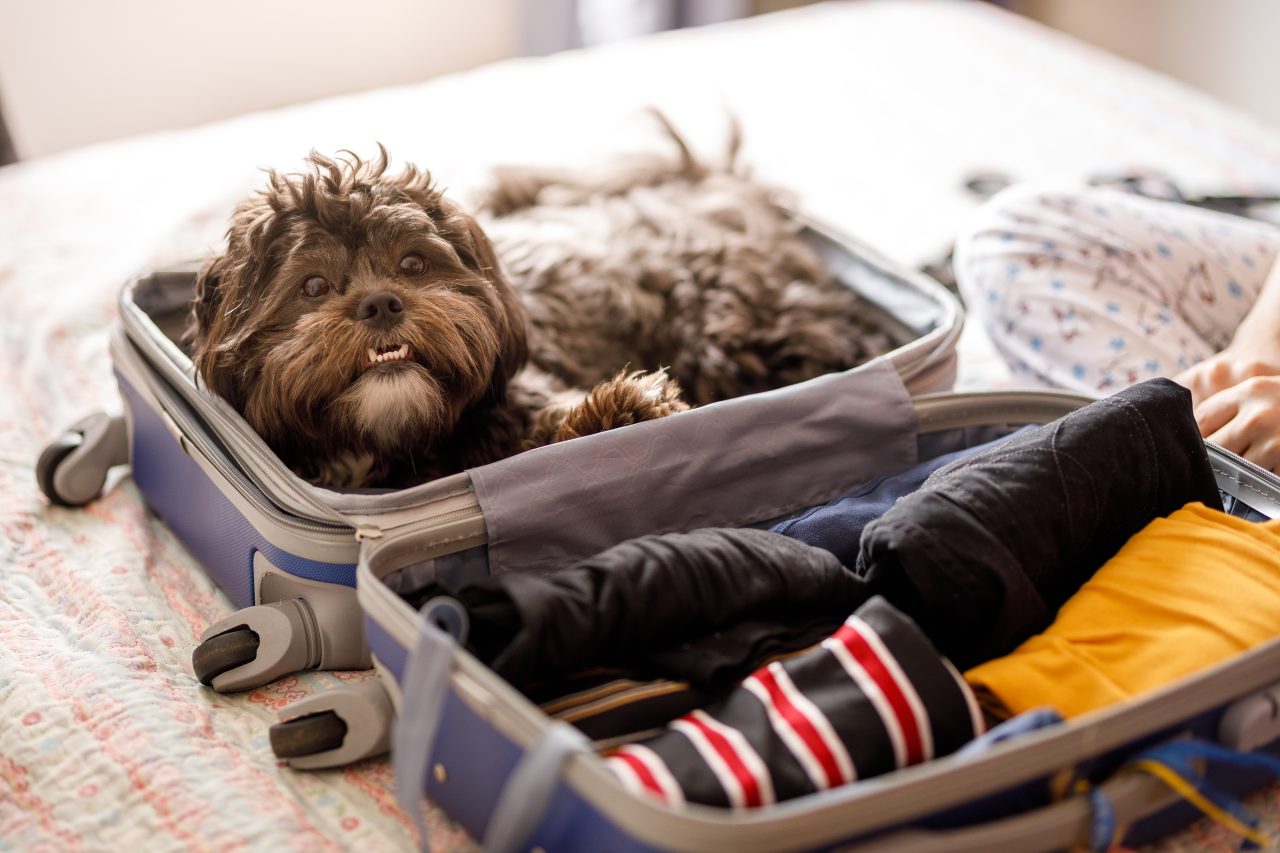
- How Much Does It Cost To Bring A Pet On An International Flight?
You’ll quickly see that there are a lot of variables when it comes to flying with animals. Flying with big dogs in the cabin domestically will be a completely different experience than traveling with a cat to Europe, and that extends to the prices you can expect to find.
Before we get into comparing the prices from some of the most popular airlines flying to European countries, it’s a good idea to consider whether your pet can join you in the cabin or if they’ll have to fly as cargo or checked baggage in the hold. Keep in mind that you may not be able to bring your pet on vacation at all, as some airlines only allow animals onboard if you’re flying with service dogs.
Let’s take a look at the fees for international travel with animals from a range of airlines, mostly relevant for anyone traveling with a dog on a plane or a cat.
Note: Pets flying as ‘checked baggage’ will travel in the hold on the same flight as you, while animals flying as ‘cargo’ may travel on a different plane to you. Airlines will usually try to ensure your pet reaches the final destination at a similar time to you, where possible.
- Can You Bring Pets To European Countries?
While many countries welcome pets, you’ll find that a significant number of them will only accept animals that have traveled in the hold. In other cases, your destination may permit you to bring particular pets, usually dogs and cats, into the country. However, flying with other animals, like reptiles or rodents, may be prohibited.
Many European nations will allow flying with your dog or cat in the cabin, but you may be transiting in a country with stricter regulations.
Some countries that only allow pets to fly in the hold include:
- New Zealand
- United Arab Emirates
- All countries within the United Kingdom
- What Countries in Europe Can My Pet Travel To?
Animal lovers can breathe a sigh of relief, as there are plenty of international dog-friendly and cat-friendly travel destinations in Europe. While it’s vital to do research specific to your final country, as well as any locations along the way if your itinerary includes stopovers, here are some popular countries that welcome pets without the need for quarantine. These are specifically related to dogs and cats.
- Most EU countries, including Germany, Italy, France, Spain, The Netherlands, Belgium, Croatia, Czechia, and Austria.
- Switzerland

- Pet-friendly adventures: traveling to Germany with your beloved companion.
- Italian escapade with your pet: explore the possibilities of travel.
- Pack your bags and paws: pet travel made easy to France.
- Wander Spain alongside your pet: unleash memorable journeys.
- Furry friend included: embark on a journey to the Netherlands with your pet.
- Experience Belgium together: unforgettable travel with your pet.
- Tail-wagging travels: navigate Croatia with your faithful pet.
- Pet-ready for Czechia: search for ultimate pet-friendly flights with your furry friend.
- From home to Austria: pet-friendly travel options await your journey.
- Embark on a pet-friendly journey: find flights for your furry friend to explore Switzerland
- Wings for paws: discover Norway — one of the best pet-friendly countries in Europe
- Furry companion’s adventure awaits: explore and book pet-friendly flights to Turkey
- What Airlines Allow Pets In The Cabin Internationally?
Here, we’ve broken down the airlines that allow pets on international flights to travel in the cabin, though this will sometimes change based on the connecting and final destinations, as some countries won’t permit pets to travel in the cabin even if the airline allows it. Animals traveling in the cabin must usually be small and fly in carriers that fit easily under the seat.
As a side note, while the United Kingdom is in Europe, it’s not in the EU and has many different regulations, which you can find here. As such, animals, except service dogs, can only travel in the hold when entering the U.K.
Below, you’ll find some pet-friendly airlines that fly to Europe and what animals they allow in the cabin.
U.S. Airlines:
- Delta – Dogs, cats, household birds
- United – Dogs, cats
European Airlines
- K.L.M – Dogs, cats (within Europe)
- Lufthansa – Dogs, cats
- Air France – Dogs, cats
Other International Airlines
- Air Canada – Dogs, cats
- Turkish Airlines – Dogs, cats, household birds
- What Documents Will I Need For Flying With My Pet To Europe?
After you’ve picked your holiday destination and airline, the next thing you’ll want to start thinking about is the documentation you need. In order to comply with the airline and country requirements, you should consider how to obtain a health certificate, if your destination imposes quarantine for animals, and what vaccines your pet needs.
We’ve put together all the must-know information about the documents you’ll need to help you get organized for your flight.
What Are Pet Health Certificates for International Travel?
Many countries have their own particular health certificate requirements, but you may find yourself visiting somewhere that doesn’t require a country-specific document.
If this is the case for you, getting a United States Department of Agriculture (USDA) International Health Certificate from a certified vet if flying from the U.S. is best. This will usually contain relevant information about your pet’s health and your contact details, confirming they’re safe to travel.
Check with your airline to see their health certificate requirements, as some airlines will ask for them to be dated no more than 10 days before the flight.
Are There Any Specific Health Certificates For Pet Travel I Should Use?
Pet owners traveling with their cat or dog to Europe, specifically to an EU country, will need to get an EU animal health certificate issued within 10 days before the animal enters the Union.
It’s helpful to know that non-EU European countries, such as Switzerland, will often accept this document too. However, if you’re traveling to a European country outside the EU, be sure to double-check that the EU health certificate is accepted.
What Do I Need To Know About International Health Certificates For Dogs?
Health certificates can vary depending on the animal, but let’s take a look at what an example of this document for a dog would contain and how to get one for your pup. You’ll need to make an appointment with a certified vet authorized to provide health certificates. It’s best to aim for a visit less than 10 days before your trip, but your destination and airline may have different time frames, so it’s a good idea to find out their requirements first.
When you’ve booked your dog in for their check-up, the vet will examine your pooch and determine whether it’s safe for them to travel. Dogs that are older, prone to certain illnesses, or in poor health may not be given the go-ahead from the vet, so it’s essential to be aware of this when planning your vacation.
If the vet is happy to let your pet travel, they’ll issue a health certificate filled with important information about your dog. This usually includes your dog’s age, breed, size, microchip number, and vaccination history, stating that your pet is free from disease and in good health. Completed health certificates will also include your contact details.
Do I Need Any Other Pet Travel Documents?
The most commonly required travel documents for your pet include:
- International health certificate
- Vaccination records (especially for rabies)
- Microchip (15-digit numbers are preferred in Europe)
While you may have three separate documents, all of this information is often contained in the health certificate, helping you cut down on the paperwork you’ll need to organize.
When animals travel on a separate plane to their owner, there are generally some additional documents to fill out, such as a written declaration that you’ve permitted another person or a transporting company to fly with your pet.
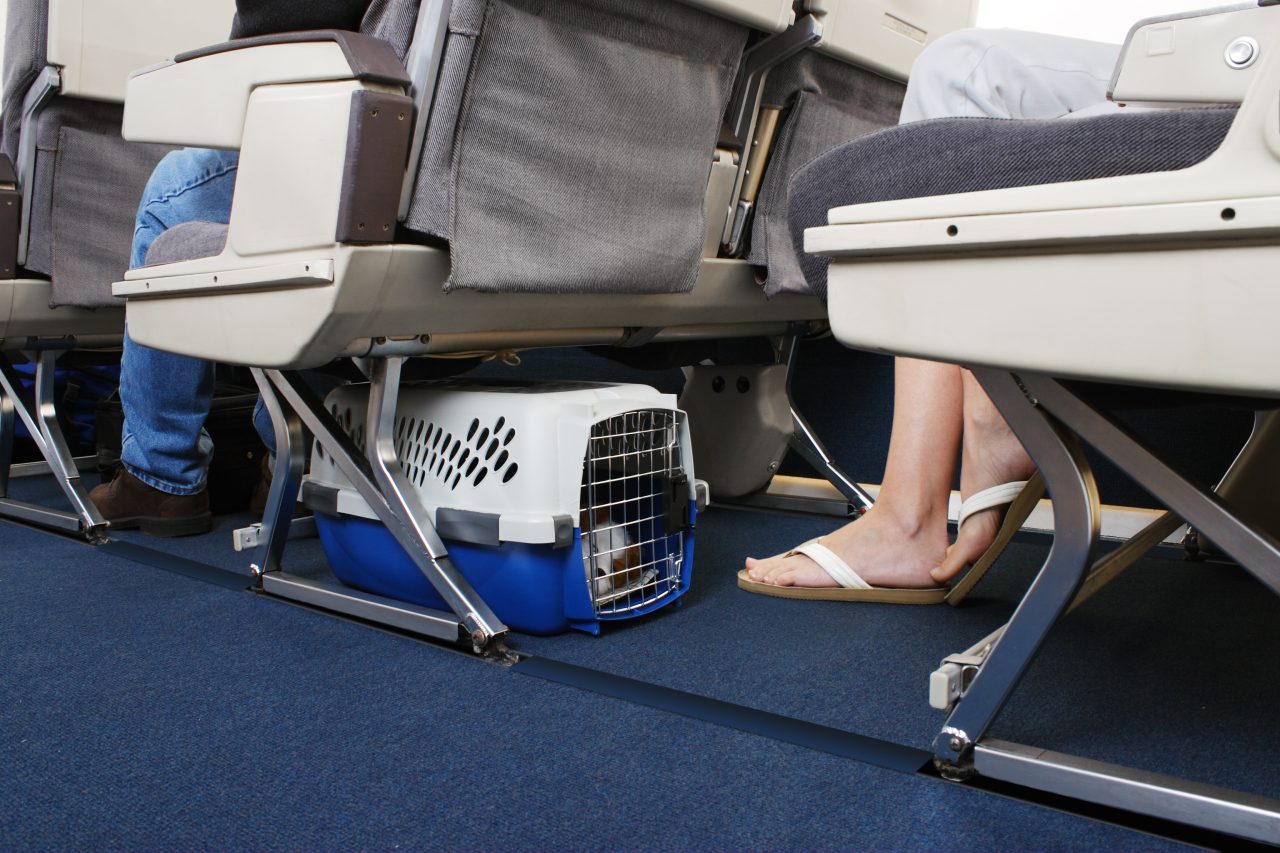
- Will My Pet Need To Be Quarantined In Europe?
Quarantine will surely be a concern for any pet owner, but there’s no need to worry about this when visiting Europe. Provided you have supplied the necessary documents, you’ll be able to reunite with your pet an hour or two after landing. After you’ve collected any checked baggage, you can go to an assigned section in the arrivals area and pick up your companion.
While this is true for dogs, cats, and ferrets, you’ll need to research country-specific regulations if flying with reptiles, birds, rabbits, and aquatic animals.
- What Vaccinations Will My Pet Need to Enter Europe?
There are a few vaccines and treatments that your pet must have before traveling to Europe, such as:
- Rabies: Dogs, cats, and ferrets must be fully vaccinated against rabies and have received their first shot at least 21 days before entering the EU.
- Rabies test: Dogs, cats, and ferrets entering the EU from certain countries must also undergo a blood test to check for rabies immunity. This includes European countries like Albania, Montenegro, and Serbia.
- Tapeworms: Dogs traveling to Ireland, Northern Ireland, Finland, Norway, or Malta must have anti-Echinococcus treatment before departure.
- Avian Influenza H5 and H7: Needed for birds entering the EU and administered no more than 60 days before travel.
What Is A Pet Passport, And Do I Need One For My Pet?
You’ll often hear the terms ‘pet passport’ and ‘animal health certificate’ used interchangeably, but they can mean different things.
Technically speaking, pet travel certificates are issued for single trips or within short periods. In the EU, these last for four months, provided you don’t leave and re-enter the Union. These permit pets to travel for a given number of days, but owners will need to get a new certificate for any additional trips once they’ve expired.
Pet passports are commonly used and issued in EU countries. Unlike health certificates, they don’t expire as long as they’re kept up-to-date with vaccine requirements. Though they’re accepted when flying between EU countries and other European destinations, like Switzerland, Iceland, and Monaco, they can’t be obtained or issued in the U.S. or U.K.
As a result, anyone flying from the United States or the United Kingdom to most European countries will require an animal health certificate rather than a pet passport.
Is It Possible To Get An International Pet Passport?
At present, there’s yet to be a standard international pet passport that’s widely accepted in most countries. EU pet passports are great to use if you reside in a member country or other select European countries, but these can’t be used elsewhere.
For this reason, animal health certificates continue to be the norm for most destinations.
- What Will I Need For Flying To Europe With A Pet From The U.S.?
To help you prepare for your visit to Europe from the U.S. with your pet, here’s a list of things you’ll need:
- A valid health certificate that states your pet is up-to-date with rabies vaccinations, fit to travel, and in good health.
- Once a certified vet completes the certificate, it must be sent to the USDA for approval and returned to you.
- Details of your pet’s microchip information (10-digit numbers are standard in the U.S. and are not accepted in the EU. You’ll need to get a 15-digit ISO-compatible microchip).
On a side note, if you need to change your pet’s microchip from a 10-digit to a 15-digit chip, it’s vital to know any vaccinations your pet received with the original chip will be invalid. This can be frustrating if you’re coming from the U.S., but knowing in advance can save you from taking your pet for additional rabies shots before getting a new microchip.
- What Should I Know Before Flying With Pets To France?
Although most regulations and requirements are standard amongst EU countries, there can be some variances between countries. Here are some things to be aware of when traveling to France with your pet :
- Pets can enter France in the cabin, as checked baggage or cargo.
- If arriving from a non-EU country by air, pets can only enter at Paris, Lyon, Toulouse, Marseille, Nice, or Reunion airports.
- Rabies vaccinations can’t be administered before puppies or kittens are 12 weeks old, meaning traveling to France with young animals may not be feasible.
- Mastiffs and pit bulls are prohibited. Other breeds, like rottweilers and Staffordshire terriers, can only enter France as guard dogs.
- Birds must be quarantined for 30 days before or 30 days after flying to France.
- Fly with your beloved pets to Paris .
- Book your pet-friendly adventure: explore Lyon getaways .
- Search for pet-friendly flights: Toulouse awaits .
- Discover new horizons: fly with pets to Marseille .
- Explore Nice: find flights to journey with your pet .
- What Should I Know Before Flying With Pets To Italy?
Another hugely popular European destination, Italy, has some of its own requirements for animals entering the country, such as:
- Pets like dogs, cats, and ferrets from non-EU countries can only enter Italy by air at Rome, Turin, Milan, Pisa, or Bologna airports.
- Pet birds can only fly to Rome or Milan Malpensa airports .
- Rottweilers are not allowed to travel to Italy .
- You can take up to five animals in total to Italy, including exotic pets like common reptiles and small turtles, as well as rodents and rabbits.
- Unleash adventures: book pet-friendly flights to Rome.
- Your furry friends deserve the best: fly to Turin with them .
- Unlock exploration: fly with your pets to Milan.
- Wings for wanderlust: discover pet-friendly flights to Pisa.
- Pets included: search for flights and explore Bologna together

- What Do I Need To Know About Flying With A Cat To Europe?
Much like flying with small dogs, taking a flight with a cat is considerably more straightforward than traveling with large dogs on planes. Unless you happened to be flying with an exceptionally huge cat, that is!
Cats are often some of the easiest pets to travel with, as you can take them into the cabin with you as long as your airline and destination permits it. In Europe, only a handful of countries prohibit pets in the cabin, such as those in the U.K.
Flying with your cat internationally should be pretty uncomplicated as long as you have completed all the necessary checks and paperwork.
- What Are The Rules For Flying With Emotional Support Pets To Europe?
Emotional support animals are subjected to the same rules as other pets for the most part. This means that, unlike trained service dogs, when you’re flying with therapy dogs, there’s no guarantee that they can travel in the cabin with you.
Your animal must meet the airline’s size, breed, and temperament requirements to fly in the cabin. As we’ve previously mentioned, some airlines and countries require all animals to travel in the hold, with the exception of service dogs.
Therefore, you must be aware of the criteria you must meet for your pet to travel with you. If an airline allows pets in the cabin, usually the animals must:
- Be a well-behaved cat or dog.
- Weigh less than 7-9kg.
- Comfortably fit in a soft or hard-sided carrier within specific dimensions that can be placed under the seat.
However, it’s worth getting in touch with different airlines, as some of them may have looser rules for flying with a large dog.
- What Are Some Other Tips For Flying With Pets To Europe?
Take a look at some of our other top tips to make your travel experience to Europe with your pet as smooth as possible!
- Start planning your trip earlier than you usually would. Giving yourself extra time will allow you to compare different airlines, read up on safety requirements, stock up on travel accessories, and plan when to take your pet for their health certificate check-up.
- Research the requirements of the European country you’re traveling to, particularly if it’s a country that’s not an EU member.
- Ensure your airline permits pets to fly to the country you’re visiting. For example, flying with dogs with JetBlue might be possible in the U.S., but they don’t allow animals on European routes, even if the final and connecting destinations welcome pets.
- Check that your destination is pet-friendly, as you could find that you can’t bring your furry friend into many businesses and spaces in some countries. Fortunately, most European countries are welcoming to pets, but it’s always best to do plenty of research.
- Book your flight early if possible, as many airlines cap the number of animals traveling per plane. Other airlines only allow you to add a pet to your booking within 14 days before departure.
- Try to stick to direct flights whenever possible. Connecting flights can make flying more stressful for you and your pet. The additional documentation, different protocols, new rules, and added fees associated with layovers can make connecting flights a logistical nightmare. Your pet will likely be faced with more unfamiliar faces and surroundings, too, so direct flights are best to minimize your four-legged friend’s anxieties.
- Begin crate training your pet a few months in advance, mainly if they’re not used to spending hours at a time in kennels or carriers. Make the crate a comfortable space where they feel inclined and safe to enter.
Want more interesting tips and information on traveling? Read more Kiwi.com articles!
- Introduction
- What Is A Pet Passport

Frequently asked questions
- Travel with kids

- Application Requirements
Traveling With a Dog to Europe: 10 Vet-Approved Tips
By Jessica Kim
Updated on Apr 9, 2024
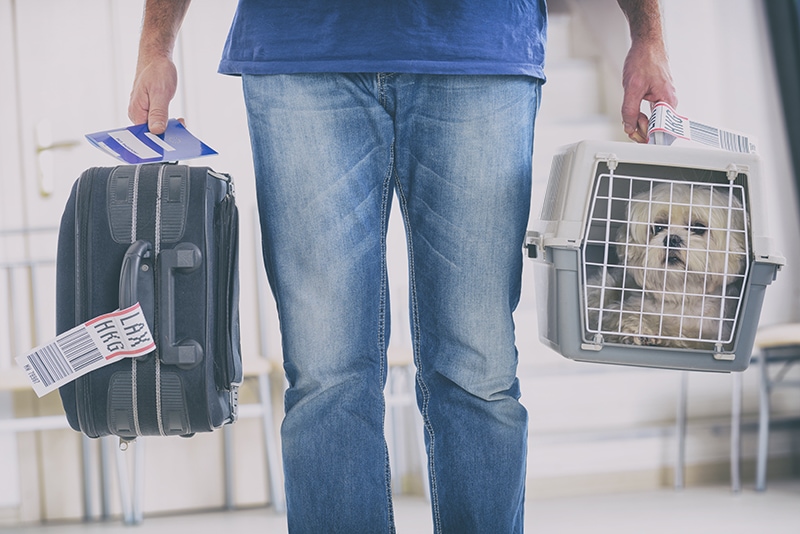
Vet approved
Reviewed & Fact-Checked By
Dr. Maja Platisa
In-House Veterinarian, DVM MRCVS
The information is current and up-to-date in accordance with the latest veterinarian research.
Traveling to Europe with your dog is a great way to create fun memories and make your travel experience unique. However, there’s no denying that it takes extra time and planning to ensure your dog is ready to travel. You’ll have to make sure that you obtain all the necessary travel documents and work with airline companies and hotels that can accommodate dogs.
It can feel overwhelming as you’re trying to figure out how to travel with your dog to Europe. So, we’ll go over the basics of what you need to do to ensure that you and your dog can travel together.
The 10 Tips for Traveling With a Dog to Europe
1. research the destination country’s travel policy.
Before you start booking flights, make sure to familiarize yourself with your destination country’s pet travel laws. If you’re going to a country that is a member of the European Union, you can start your research by viewing the European Union’s travel requirements for pets. Just keep in mind that while most countries in the European Union have similar travel policies, some can have slightly differing requirements for the types of vaccinations your dog will need.
2. Get Your Dog Microchipped
In order to enter a European Union country, your dog must be microchipped. It’s most convenient to use an ISO-compliant microchip, as customs officials will have scanners for these types of microchips. If your dog hasn’t been microchipped with an ISO-compliant microchip, you can either bring your own scanner for your dog’s current microchip or have your veterinarian implant a second one.
Microchipping is still important even if a country doesn’t require it. Traveling can be stressful for dogs, and they’re often more prone to wandering off and getting lost. So, getting your dog microchipped and updating the information associated with the microchip is a standard practice for pet travel.
3. Schedule a Veterinarian Appointment
One of the most significant documents you’ll have to obtain is a pet health certificate. You can start to apply for this certificate by visiting a federally-accredited veterinarian, which is a veterinarian that’s authorized to endorse pet health certificates. A federally-accredited veterinarian can conduct a physical exam and make sure that your dog gets all the vaccines, tests or treatments that are required by the country you’re entering.
Keep in mind that some European countries have varying waiting periods for dogs that can enter their country after they’ve gotten a specific vaccine. So, it’s extremely important to schedule a veterinarian appointment as soon as possible in case your destination country requires a waiting period.
4. Receive a USDA Endorsement
Many countries require a health certificate that’s endorsed by the USDA. You can obtain a USDA endorsement by having an accredited veterinarian complete, sign, and date a health certificate. The veterinarian will submit the health certificate to the USDA or provide sufficient paperwork so that you can submit it yourself. The processing period can vary, and it can take several weeks for the paperwork to be processed and endorsed.
5. Book Flights With the Right Airlines
Make sure to read through each airline company’s pet travel policy because they can differ from one another. For example, some companies don’t allow dogs to travel in cargo, and others won’t allow pets on flights that last over a certain number of hours. It’s also important to find out if a company has breed restrictions and won’t allow certain dog breeds on their flights.
It’s best to contact an airline company directly to get the most updated information on their pet travel policies. A representative will be able to walk you through all the documents you need to obtain and ensure that your dog is able to travel with them.
6. Find a Pet-Friendly Hotel
It can take some time to find a pet-friendly hotel abroad, so try to begin your search as soon as you can. Pet-friendly hotels will have their own rules and regulations with dogs on their premises. Most won’t allow unleashed dogs in shared spaces, and some won’t allow dogs to remain unattended in their rooms. As with airline companies, it’s best to contact pet-friendly hotels directly to get their most updated pet policies, as they can change at any time.
7. Purchase an Airline-Approved Travel Crate
Once you’re ready to book a flight with an airline, check to make sure that you have a dog crate that’s compliant with the airline’s requirements. Dogs traveling in-cabin must remain in their crates throughout the duration of the flight, and they must be stowed beneath your seat. So, it’s important to find a crate that’s both comfortable for your dog and in compliance with the airline’s dimension and size requirements.
If you’re looking for a new travel dog crate, it’s best to start your search by asking your airline company if they have any specific recommendations. You must also get your dog acclimated and comfortable inside the crate, so it’s important to start or brush up on crate training at least a few weeks before your flight departure date.
8. Be Prepared at Customs
Make sure that you have all your paperwork in one place so that you can enter and exit customs with ease. You should have your dog’s endorsed health certificate on hand, and it’s also helpful to have their microchip ID written on any travel documents so that the customs officer can view and verify them quickly.
If your dog is traveling in cargo, you’ll receive a tracking number, also known as an air waybill number, after you’ve checked them in. Make sure to keep this number in a safe spot, as you’ll need it to claim your dog in customs.
9. Consider Getting an EU Pet Passport
If you plan to be abroad in Europe for a long time and will travel to different countries, you may want to consider getting an EU Pet Passport. An EU Pet Passport is an official health document that enables dogs to travel through EU countries with just one health document rather than having health documents for each individual country. The purpose of this passport is to make traveling with dogs easier, but it’s not necessary, especially if you only plan to visit one country.
An EU Pet Passport cannot be issued in the US , and you’ll have to schedule an appointment with an accredited veterinarian in an EU country to obtain one.
10. Take It Easy on the First Few Days in Europe
Traveling can be very stressful for dogs , so it’s important to take it easy once you arrive in Europe. Make sure to spend the rest of the day with your dog, check on their condition, and look for any signs of illness. It’ll also be helpful to map any vet clinics near your hotel in case of any emergencies.
It’ll take a few days for your dog to adjust to being in a new country, so try not to engage in any over strenuous and over stimulating activities right away.
When traveling to Europe with dogs, it’s best to have as much time as possible on your side.
Getting a USDA endorsement on health certificates can take several weeks, and some countries have vaccination waiting periods. So, make sure to contact a federally-accredited veterinarian and start the process of getting a health certificate right away. If you have any questions about pet travel , it’s best to contact the USDA or the embassy of your destination country to obtain the most accurate and updated information.
- https://www.avma.org/resources-tools/pet-owners/petcare/microchips-reunite-pets-families/microchipping-faq
- https://www.aphis.usda.gov/aphis/pet-travel/pet-travel-info-and-guidance-document/pet-travel-guidance
- https://www.aphis.usda.gov/aphis/pet-travel/by-country/eu/pet_travel-european_union_pet_passports
Featured Image Credit: Monika Wisniewska, Shutterstock
Related Articles
Further Reading
11 Australian Dog Breeds (With Pictures)
Jan 23, 2024 - 7 min read
Do Cane Corsos Drool a Lot? Breed Characteristics & Facts
Jan 31, 2024 - 4 min read
Can Pugs Swim? How to Help Them Enjoy The Water
Mar 14, 2024 - 3 min read
Vet Articles
Latest Vet Answers
The latest veterinarians' answers to questions from our database
Can Two Male Betta Fish Live Together? Our Vet Explains
Answered by Dr. Luqman Javed, DVM (Vet)
Kidney Disease in Cats: Causes, Signs & Treatments (Vet Approved)
Answered by Dr. Chantal Villeneuve, MS BVetMed (Vet)
Dog Ear Hair Plucking: Our Vet Answers Concerns & Alternatives
Answered by Dr. Karyn Kanowski, BVSc MRCVS (Vet)
Betta Fish Gill Flukes: Causes, Signs, Treatment & Prevention
How to Cycle Your Aquarium Using Liquid Ammonia – Our Vet Explains
Do Cats Normally Breathe Faster When They Purr? Our Vet Explains
Answered by Dr. Iulia Mihai
Cat food recalls
Have a cat? Stay on top of cat food recalls here >
Dog food recalls
Have a dog? Stay on top of dog food recalls here >
Have a question? talk to a vet online for advice >

How to Live Abroad
- The World's Best Places to Retire
- Travel—How, When, and Where to Go
- Real Estate Overseas
- Earn, Bank, Diversify, Invest
- Retirement Planning
- How to Move Out of the U.S.
- All Destinations
- Editor's Choice
- Daily e-Letter
- Our Experts
- Testimonials
Traveling to Europe with a Dog: How to Take Your Dog to Europe - IL

I was talking to a sassy American woman on the cusp of retirement. She was buying my car and asked why I was selling a fairly new vehicle with such low mileage. When I told her I was going to Italy —with no plans to return—she got a dreamy, faraway look in her eyes…then looked a little sad. She would love to go to Europe, she said, but she couldn’t bear to leave her pets behind.
That’s when I gave her the good news: You can take your pets from the U.S. to Europe. In fact, today I’m sitting in a cozy apartment overlooking a moody autumnal landscape in Riga, Latvia, with my dog, Luna, snuggled up on the couch next to me.
Since that conversation, Luna has been to 19 European countries, and we’ve already booked #20 (Lithuania) and started dreaming about #21 (Greece).
So…how did I, a U.S. citizen, get Luna, a U.S.-born pooch here?
Research, patience, and paperwork. Here are some simple steps that will get you and your dog safely, legally, and happily to Europe.
1. Make sure your dog is healthy, microchipped, and ready for travel.
To travel internationally with your dog, you’ll need to get an international standard microchip (HomeAgain is a common brand) and make sure your dog is up-to-date on his or her vaccines (especially the rabies shot, of which the most recent shot must be given at least 21 days and no more than 12 months before your trip).
Many countries, including all those in the European Union, require pet dogs, cats, and ferrets to be microchipped before travel. A microchip compatible with ISO standard 11784 or 11785 is recommended. If your pet has a different microchip, consider buying a microchip reader and taking it with you. And note that, if you have to get your dog microchipped, you must do it before you get your dog’s latest rabies vaccine, so at least three weeks before your trip.
2. Check the dog travel policies of your preferred airline.
On some airlines, like Delta, XL Air, or Air France, a few small dogs are allowed to travel in-cabin, while large dogs travel as cargo. Other airlines require that all pets travel as cargo. Keep in mind that many airlines don’t accept pets in cargo during the hot summer months, as this area isn’t air conditioned while the plane is on the runway.
3. Check the requirements and fill out the paperwork for your first destination.
Bear in mind the requirements are set by the country of destination, not the U.S. If you are arriving directly in Italy, you’ll need a veterinary certificate in English and Italian. If you are flying into France , you’ll need one in English and French. And if you are cruising or flying into the U.K., there are a few extra guidelines you’ll need to follow and extra fees you’ll need to pay, which you can find on the DEFRA website .
For any of these countries, you’ll need a USDA-approved vet to fill out the above mentioned paperwork, usually within 10 days of travel (in the case of the U.K., within 5 days). Make sure to ask the vet about their certification. Then you can either mail your papers or drive over to the nearest USDA office for a stamp of approval. This stamped paperwork is what the customs officials will want to see when you arrive.
Keep in mind that each USDA office has slightly different policies (for example: in San Diego, I had to show up between certain hours and wait in line for my paperwork approval; in Denver, I had to make an appointment), so contact your local office ahead of time to find out about appointments, fees, and payment options for the fees.
4. Make sure you’re ready for travel.
If you have a nervous dog, ask your vet about safe sedatives for the trip and make sure to bring your Thunder Shirt or a comforting toy. This is only recommended for dogs traveling in-cabin where you can supervise them.
If you’re flying with your pet in-cabin, you’ll need a soft-sided, flexible pet carrier that will fit under the seat (and don’t trust the marketing—you can find airline seat measurements at www.dogjaunt.com and measure carriers to make sure they’ll fit). You may also want to bring treats to keep blood sugar levels up, a portable water bowl, and pee pads (if your dog is trained to use them), which you can take to the bathroom for a mid-flight potty break.
If your dog is flying as cargo, make sure your hard-sided case meets the airline’s requirements (which vary from airline to airline and can be found on the airline’s website) and consult with your vet about how much food or water to leave with your pet.
5. When traveling between European countries…
The USDA paperwork is officially good for travel within the E.U. for up to 90 days. If you are traveling in or moving to the E.U. for more than 90 days, you’ll need to complete one final step: getting your European pet passport. This passport documents all vaccinations and health check-ups and allows your dog to travel freely in between European countries.
To get a pet passport, you’ll need to make an appointment with a local vet in your first destination. They’ll check your vaccination records (so make sure you have those) and your pet’s microchip and fill out a small passport style booklet that declares your pet micro-chipped and healthy. Usually, this process can be done in the office same day, but it’s always smart to give yourself an extra day or two just in case (my first pet passport, for example, ended up taking two days and two visits due to a typo).
A handful of European countries have additional requirements for pet travel, so if you’re traveling to multiple countries, always make sure to check the official requirements before you go. Norway, and the U.K., for example, require a tapeworm treatment administered by a vet five days (or less) before you cross their borders. And if the U.K. executes a no-deal Brexit this year, there will be additional paperwork required to travel between the E.U. and the U.K.
European countries not yet in the E.U. are also subjected to additional requirements (Montenegro, for example, is a high rabies risk country and you will need a blood titer test done by an E.U.-approved lab at least 30 days before your trip if you want to re-enter the E.U. after visiting the pretty coastal vacation spot).
6. Finally, enjoy your new home.
Dogs are absolutely adored in France, Italy, and other European countries. They’re often allowed in restaurants, cafés, bars, and shops. Overall, Europe is far more pet-friendly than the U.S.
Related Articles
Europe’s Top 5 Affordable Retirement Havens
11 Places in Europe Where You Can Retire on $35,000 a Year
5 Months on the Road Discovering Europe’s Best Culinary Delights
Cookies on GOV.UK
We use some essential cookies to make this website work.
We’d like to set additional cookies to understand how you use GOV.UK, remember your settings and improve government services.
We also use cookies set by other sites to help us deliver content from their services.
You have accepted additional cookies. You can change your cookie settings at any time.
You have rejected additional cookies. You can change your cookie settings at any time.
New rules for pet travel from 1 January 2021
Pet owners will need to follow new requirements before taking their pet to the European Union or Northern Ireland at the end of the transition period.

Pet owners are being encouraged to check the latest government advice about travelling from Great Britain to Northern Ireland or the European Union with their pets at the end of the transition period.
The government has worked alongside the European Commission to ensure pet travel can continue between Great Britain and the EU and Northern Ireland at the end of the transition period.
From 1 January 2021 onwards, the UK will have Part 2 listed status under the EU Pet Travel Scheme, meaning that people travelling from GB with their pets and assistance dogs will need to follow new requirements in order to travel to the EU and Northern Ireland.
Before taking their dog, cat or ferret to the EU for the first time after 1 January 2021, pet owners must complete the following steps. The only new requirement for travel to the EU is the use of a certificate, rather than a pet passport:
- Ensure their dog, cat or ferret is microchipped.
- Ensure that their dog, cat or ferret is vaccinated against rabies – pets must be at least 12 weeks old before they can be vaccinated.
- Wait 21 days after the primary vaccination before travel
- Dogs must be treated against tapeworm 24-120 hours before landing, if they are travelling to a tapeworm free country.
- Visit their vet to get an animal health certificate (AHC) for their pet, no more than 10 days before travel to the EU.
Pets and assistance dogs will also need to enter the EU through a travellers’ point of entry (TPE) , which includes all the major French ports such as Calais, Caen and Dunkirk.
All of these requirements will also apply for movements of pets and assistance dogs from Great Britain to Northern Ireland. However recognising that these changes will take time to adjust to, the UK Government is working with the Department of Agriculture, Environment and Rural Affairs (DAERA) in Northern Ireland on an enforcement approach that takes this challenge into account. This approach will be implemented in a way which supports pet owners and assistance dog users while the Government pursues a permanent solution.
There will be no change to the current health preparations or documents for pets entering Great Britain from the EU or Northern Ireland from 1 January 2021.
Christine Middlemiss, UK Chief Veterinary Officer, said:
We have been granted ‘Part 2’ listed third country status by the EU which will ensure that travelling with your pet continues from 1 January onwards. Your vet will be able to advise what you need to do in order to obtain the correct documentation to travel and you can find the latest pet travel advice on gov.uk or by searching ‘pet travel’.
Updated guidance on pet travel has been available since November 2018, ensuring that owners will be ready for any future scenario, so many pet owners will already be familiar with that they need to do.
The UK government is continuing to press the European Commission to secure Part 1 listed status. The UK has one of the most rigorous pet checking regimes in Europe and currently meets all the requirements for Part 1 listed status under the EU Pet Travel Scheme.
The latest advice for pet owners seeking to travel to the EU after 1 January 2021 can be found here .
Further information
- Passengers should always check the rules of the country they are travelling to for any additional restrictions or requirements before they travel.
- For information on commercial imports and exports of dogs, cats and ferrets to the EU – please refer to the Border Operating Model
- There will be no changes or new requirements on movements from Northern Ireland to Great Britain.
- There will be no changes to the current health preparations or documents for pets entering Great Britain from the EU in the immediate term, as the disease risks remains unchanged.
- There are no restrictions on bringing pet rodents, rabbits, birds, invertebrates, amphibians and reptiles to the UK from EU countries.
- Contact the Centre for International Trade (Carlisle) for more information on the rules for travelling with other species of pet.
Share this page
The following links open in a new tab
- Share on Facebook (opens in new tab)
- Share on Twitter (opens in new tab)
Related content
Is this page useful.
- Yes this page is useful
- No this page is not useful
Help us improve GOV.UK
Don’t include personal or financial information like your National Insurance number or credit card details.
To help us improve GOV.UK, we’d like to know more about your visit today. We’ll send you a link to a feedback form. It will take only 2 minutes to fill in. Don’t worry we won’t send you spam or share your email address with anyone.

Traveling to Europe with a Dog
Categories International Travel with a Dog , Travel Europe , Travel with a Dog

Despite the airlines’ best efforts to dissuade pet travel, more and more dog parents are considering bringing along their pets on their travels to Europe. Given the popularity of the continent and the relative proximity to North America, it’s a fairly easy international trip to make with your furry friend in tow.
Traveling with your pet to Europe isn’t all that complicated, however it does require some advanced planning and requirements differ among countries that are within the EU opposed to those that are not.
For the sake of simplicity, this post will focus on the pet entry requirements for the European Union. We will note exceptions for travel to the UK and other similar countries that have different or more strict mandates for dogs and cats.

What do I Need to Travel with my Dog to Europe?
Iso microchip.
Europe operates on a different frequency from the United States, so you will likely need to implant a second one in your dog. Only the veterinarian who implants the microchip can sign the required microchip implementation form.
While it is possible to bring your own scanner, we had one friend who did, but it required extra paperwork and hassle at customs. Save yourself the delay and just get a second microchip. This way, if your dog is lost during your trip a veterinarian can scan the chip.
One-year Rabies Vaccination
This must occur AFTER the ISO Microchip implant . The rabies and the microchip can be done in the same day, but the vaccination has to come second. Both must be administered at least 21 days prior to departure.
While some countries will take the 3-year rabies vaccination, however, the initial shot after the microchip has to be a one-year vaccination. Booster shots may be the three-year injection.
International Health Certificate from Your Veterinarian
Ten days before departing for the EU , visit your local veterinarian for an international health certificate and an EU veterinary certificate. You have 10 days to enter the destination country after you have completed the paperwork. Plan accordingly and consider travel snafus like delayed or missed flights.
Official Pet Export Paperwork
Make an appointment with the USDA (or your local governmental agency responsible for pet export. The international health certificate, the EU veterinary certificate, and the microchip implementation form must be endorsed by a USDA APHIS . This is the government office responsible for approving your export request and stamping your forms.
You can choose to schedule an appointment with the nearest location or overnight the paperwork. Schedule early because appointments can fill fast. Visiting is always the safest option. Note that the fee for endorsement may only be paid by check or money order.
Traveling outside of the EU?
Norway, Finland, Ireland, Malta, and the United Kingdom require an echinococcosis (tapeworm) treatment given a minimum of 24 and a maximum of 120 hours before arrival. The paperwork mentioned above remains the same.
The treatment required approval from the USDA accredited veterinarian. Be sure to ask your local vet write the date and time in both your current timezone, and the one to which you’re traveling on the export paperwork. With a nine hour time difference, this can affect meeting the requirements for inoculation. Always double check your country of destination that may not be listed here. The rules can change.
Our post on entering the UK with a pet should help cover the exceptions and additional requirements, but always, always check before making assumptions.
Entering the Destination Country by Air
If you’re flying with your pet , check to see if the destination requires that you call customs. Not every EU country requires meeting with customs upon arrival, however some countries do. They generally ask for a 24 hour notice.
When we went through customs in Norway, we had to enter the “goods to declare” section. There, we met the customs veterinarian who overlooked Sora’s paperwork, scanned for her microchip, stamped a few items, and sent us on our way.
In Spain, we entered as we would, whether we had a dog or not.
Sora was an ESA, and flew with us in the cabin. We imagine the same scenario would play out for those traveling with a small dog in cabin as well. Again, this depends entirely on the destination country.
For those flying with their dog as cargo, you may be required to show your paperwork at the agricultural office located in the airport. Not all airports accept international pet transport, so check that your destination does before booking any flights.
Once you’re in the EU, you can travel freely between countries with no hassle. Just remember, this is not the case for the exemptions mentioned earlier!
Getting a Pet Passport
You’ll want to get a pet passport if you plan to travel back and forth between Europe and the US or if you plan to stay long term. Once you enter Europe, you have four months to obtain a pet passport if you plan on staying there.
The process is very simple and straightforward if you do your homework in advance. Bring all of your paperwork to a local veterinarian and ask for a Pet Passport. They’ll know what to do.
Crossing Borders in the European Union (EU)
The Schengen zone was created by the EU to enable people to have smooth borderless travel. When traveling with a rental car, bus, or train, you will not have to stop at each border. However, it is a good idea to always bring along the pet passport.
It’s worth noting that due to political conflict, some countries have implemented random border checks. We saw this first hand coming from France to Spain, where the French were randomly checking vehicles. Always have your paperwork ready to go in case you need it.
Generally speaking, it’s very rare to need to show documentation at any point once inside the EU.
Not all in the Schengen Zone are in the EU! Not all non-EU countries are part of the Schengen Zone. It’s very confusing, so we’ll say it one final time. Do your homework and know the requirements of the countries you plan to visit!
Related Reading
How to Fly Internationally with a Dog Is it Safe to Fly with a Dog? Best Dog Kennels for Flying 14 Questions to Ask before Flying with a Large Dog Flying with a Dog in Cargo Gear List
Movement of pets
The adoption of harmonised rules on travelling with pets has made it easier for EU citizens and their dogs, cats or ferrets to enjoy the freedom of movement within the Union. This significant step was made possible by dramatic advances made in the fight against rabies.
For movement between EU countries or from non-EU countries vaccination against rabies documented in the pet passport or the animal health certificate is the sole requirement for dogs, cats and ferrets to travel across EU borders, with certain exceptions.

Related links
- Poster: Diseases don't respect borders
- Poster: Keep animal diseases out of the EU
- June 2016: Commission Staff Working Document
Further information
- EU-related Countries
- Non-EU Countries
EU countries' specific information National rules that apply to the movement of animal species not affected by rabies, as well as the ones of no epidemiological significance for rabies...
- Entry into the Union from non-EU countries or territories
- Listing of territories and non-EU countries
- Movements within the Union
- Non-commercial movement from non-EU countries
- Non-commercial movement within the EU
- Young Animals
Travellers' points of entry Dogs, cats and ferrets moved for non-commercial purposes into an EU country from a territory or a third country other than Andorra, Switzerland, Faroe
Share this page

Authored by Gigi Chow
Thanks to the pandemic, remote work and dog ownership have been rising like never before. As dogs are family, many people are choosing not to leave them behind when traveling.
Besides typical road trips, people are venturing overseas with their dogs for the very first time. And yet, it’s no surprise that Europe is, by far, the most popular destination.
Almost daily, I get messages from dog parents planning an epic holiday or a long-term move to Europe with their dogs.
From Paris to Rome to Vienna, Europe boasts an abundance of renowned dog-friendly cities where it’s the norm to see dogs dining inside restaurants , hanging out at cafes, and taking a stroll at the local farmer’s market – alongside their humans.
If you are thinking of taking your dog to Europe, I’ve got you covered with this step-by-step guide.
This is a guest post from Gigi Chow, the creator behind the international dog travel blog Wet Nose Escapades . Since 2016, she has flown her ultra-bossy Yorkshire Terrier Roger Wellington on over 60 flights across 24 countries, spending most of their time gallivanting in Europe. She’s here to give you a step-by-step guide on how to take your dog to Europe.
How to Take Your Dog to Europe: A Step-by-Step Guide
#1 find a pet-friendly airline that flies to europe.
The first step is to find a pet-friendly airline that flies to Europe. Unfortunately, not all airlines allow pets onboard , and some that do may only allow pets in the cargo hold.
If your dog weighs more than 16 pounds, chances are you will have to transport him as a checked pet in the cargo hold, where baggage is generally stored.
Some airlines may allow dogs up to 20 pounds or have a combined weight limit for the dog + carrier.
Airlines that do not have a weight limit for dogs traveling in-cabin will likely require that your dog can stand up and turn around comfortably inside the carrier.
The maximum carrier dimensions may differ from airline to airline with differences between hard-sided vs. soft-sided. Regardless, flying in-cabin is undoubtedly limited to small dogs unless you have a trained service dog to assist with a disability.
Pet-Friendly Airlines in the U.S. with direct flights to Europe include American Airlines, Delta Airlines, and United Airlines.
#2 Secure the Flight For Your Dog
Once you’ve booked your flight to Europe, you must secure a space for your dog ASAP.
Most pet-friendly airlines have limited spots available for pets in-cabin on each flight, ranging from 2 to 6. Therefore, you must reserve a spot for your dog in advance.
This is usually done via phone after your booking is confirmed although some European airlines (e.g. Lufthansa) will allow you to do it online.
Fees for pet travel from the U.S. to Europe range from $125 to $200 one-way, while cargo fees can range from a few hundred to thousands of dollars, depending on the route.
#3 Shop for a Carrier or Kennel to Transport Your Dog
Once you’ve secured your dog’s flight, the next step is to find the right carrier (if flying in-cabin) or kennel (if flying in the cargo hold).
Besides keeping your airline’s maximum carrier dimensions in mind, it is imperative that you find a carrier with adequate ventilation, space, and padding to ensure a comfortable journey for your furry traveler.
In the case of a kennel, you should put more consideration into security and sturdiness to prevent a potential breakout. Get more information on how to find the right carrier for your small dog .
#4 Start Carrier or Kennel Training ASAP
This crucial step can make or break your dog’s journey!
Once you’ve found the right carrier or kennel to transport your dog on the flight, it’s time to start training your dog to feel safe and comfortable in it.
If this is your dog’s first flight, I recommend investing at least 2-3 months in carrier/kennel training before travel day.
Begin by throwing your dog’s favorite things and a few treats inside, and then letting your dog voluntarily explore. After a few days of voluntary exploration, slowly zip up the carrier (or lock the door of the kennel) with your dog inside for a couple minutes.
Increase the time spent inside the carrier as the days go on until you’ve worked it up to at least two to four hours. Daily repetition is the key to success.
#5 Prepare for the Flight
Besides carrier training, there are other ways to prepare your dog for a long-haul flight. If this is your dog’s first time flying, it’s imperative to ease his way in, which is an important step that dog parents often skip.
Regardless of your confidence in your dog’s performance on the plane, his first flight should never be a long-haul flight to Europe.
Start with one or two quick hour-long practice flights and work his way up to a four or five-hour flight before taking him on the long flight to Europe.
The more your dog can familiarize himself with the noise, crowd, and overall environment at the airport and on the plane, the better he will fare (and the less stress he’ll feel ) when the real travel day arrives.
#6 Book Pet-friendly Accommodations
As you train your dog to feel comfortable inside the carrier or kennel, you should start your online search for pet-friendly accommodations in Europe (unless you are staying with family or friends).
Since Europe is notoriously known to be dog-friendly, it is no surprise how easy it is to find hotels and apartments that accept dogs.
You’ll be surprised to find many places that accommodate dogs free of charge or for a nominal fee of 10 euros per night (per dog), which is a nice breather if you’re used to paying exorbitant pet fees at hotels in the U.S.
Be sure to apply the “pet-friendly” filter on booking apps like Hotels.com, Booking.com, and Airbnb. Get more tips on finding and saving money on dog-friendly accommodations .
#7 Visit the Veterinarian
Next up, you must take your dog to an accredited veterinarian to obtain the Veterinary Health Certificate, which is essentially your dog’s “passport” to Europe.
In order for the veterinarian to complete and sign off on the form, your dog must have a 15-digit ISO microchip, rabies vaccination , and the standard physical exam.
Although everything can be done on the same visit, whether or not you get to walk out with the completed certificate largely depends on how your veterinarian operates (unfortunately, I had to make several visits before they released the certificate because there was a designated veterinarian to complete travel documents).
If this is your dog’s first rabies vaccination, there must be a 21-day waiting period before traveling to the E.U.
Although the age minimum is 12 weeks for non-commercial dog import to the E.U., I do not recommend traveling with your dog internationally until he is at least a year old or fully potty-trained .
#8 Get the Paperwork Endorsed
From the u.s..
Accredited veterinarians can submit health certificates for USDA endorsement electronically through VEHCS (Veterinary Export Health Certification System), which saves some time.
However, E.U. countries still require USDA to “ink-sign and emboss” the health certificate.
This means that the endorsed Veterinary Health Certificate must be mailed back to you UNLESS you can get the endorsement in person by going to a USDA Endorsement office in your state , which I did since I was departing from Los Angeles at the time.
From Canada
You must get the Veterinary Health Certificate endorsed by the Canada Food Inspection Agency. You can find an endorsement office HERE .
For U.S. and Canada travelers, you must get the paperwork endorsed within ten days of arrival in the E.U.
#9 Be Strategic on Travel Day
On travel day, it’s all about strategy to ensure a smooth and comfortable journey for your dog.
While you should never overfeed your dog right before a flight, you should not fly him on an empty stomach either. Plan on feeding a light meal at least 2-3 hours before heading to the airport to allow time for digestion and relief.
Also, squeeze in some time for a slightly longer-than-usual walk or playtime to help him sleep on the plane.
Make sure he gets plenty of potty breaks before arriving at the airport and before boarding. Don’t forget to utilize the pet relief areas at the airport.
#10 Optional: Exchange Paperwork for an E.U. Pet Passport
Once endorsed, the Veterinary Health Certificate is valid for four months of travel (or whenever the rabies vaccination expires, whichever comes first).
The crazy part is that I’ve RARELY been asked to present the paperwork upon arrival in Europe from the U.S. (and I’ve flown into many different cities with my dog, including Paris, Rome, and Barcelona).
Although this makes you feel like all your hard work is in vain, it gives you a sense of security that you have everything in line to deal with any mishap.
The best part is that the endorsed certificate allows easy movement within the E.U. countries, which means that your dog can travel freely from France to Italy to Spain to Germany, etc. Dog travel throughout Europe is essentially at your fingertips!
If you plan on returning to Europe with your dog, you should exchange the endorsed certificate for an E.U. Pet Passport.
Upon arrival in the E.U., you should find an E.U. vet (who has authority to issue E.U. Pet Passports) and present the following information: the Veterinary Health Certificate, your dog’s microchip ID, and his rabies vaccination record.
Depending on where you are, an E.U. Pet Passport can be as cheap as 20 euros. Seven years ago, my dog got his passport in Budapest for less than 15 euros!
If You Liked This Post You May Also Like:
A Guide to Safe Travel With Your Pets
What to Consider Before Traveling with Your Dog or Cat
Traveling With A Pet? These Cars Fit Fido’s Style

Since resigning from the conventional office in 2016, Gigi has been living the nomadic life with her Yorkie, Roger Wellington.
She is the creator behind Wet Nose Escapades , the international dog travel blog narrated by Roger W. himself. She is also the author of How to Travel with Your Dog: Roger Wellington’s Expert Guide to International Dog Travel .
Follow their escapades on YouTube , Instagram , and Facebook .
Post a Reply Cancel reply
Your email address will not be published. Required fields are marked *
Save my name, email, and website in this browser for the next time I comment.
Search This Site

I am Megan Jerrard, professional travel blogger/journalist with a focus on adventure, discovery, immersion and inspiring you to explore!

Recent Posts
- An African Dream: Must-See African Destinations for 2024
- The Best Sustainable Ways to Get Around on Vacation
- Navigating Food Choices Abroad for Health-Conscious Adventurers
- 6 Thoughtful Gestures to Make Mom Feel Special from Anywhere in the World
- Unforgettable Indonesian Cruise Tours & Packages: Exploring Islands from Bali to New Guinea
Popular posts
- International Love: Maintaining a Long Distance Relationship
- Illegal Ink – 11 Countries Where Showing Your Tattoos Could Get You Kicked Out!
- 7 Things To Know Before Travelling by Overnight Train in Vietnam
- A Travelers Guide to Tap Water: Countries Where The Drinking Water is Unsafe
- Countries That Don’t Celebrate Christmas

Flying to Europe with a Dog from the USA
Europe is the most dog-friendly part of the world to travel with a dog. It’s no wonder then that if you live in the USA, that you might want to consider taking your dog along with you on a European vacation . But how easy is it to fly to Europe with a dog from the USA? And what other considerations do you need to keep in mind when flying to Europe with a Dog?
Specifically travelling to the UK or France? Also check out my tips on flying a dog from USA to UK and my quick guide to flying a dog to France from the USA .

Note: This post contains affiliate links, which means I may receive commission if you make a purchase using the links. See my full disclaimer .
Preparations Before Flying to Europe with a Dog
One of the first things you need to consider when you decide to take your dog to Europe, is the veterinary and paperwork preparations that are required. For dogs travelling to the European Union (the majority of countries in Europe), I list all the steps in this post , plus briefly cover the requirement for other non-EU countries.
Key Steps to Travel to Europe with a Dog
If you’re travelling directly from the USA to the EU (and most other European countries), the steps required are quite simple:
- Microchip your dog
- Vaccinate your dog against rabies
- Complete an animal health certificate
Your dog is likely already already vaccinated against rabies, but if it doesn’t have a microchip, then it will need to be microchipped and then re-vaccinated. Note that the microchip needs to be ISO compliant and readable by standard microchip readers (or provide your own). If your dog is being vaccinated against rabies for the first time, the vaccine needs to be done at least 21 days before arriving in Europe.
If you aren’t travelling to the EU with your dog, carefully check the rules listed for your destination country. A good resource is the APHIS Pet Travel website – select your destination country.
Getting an EU Animal Health Certificate
The trickiest part is getting an EU animal health certificate (or “EU Annex IV”), or the alternative health certificate for your destination country.
This needs to be issued by a accredited veterinarian – double check whether your vet is accredited or search on this website . According to the APHIS website, this certificate is then valid for 30 days after it is issued, at least for some countries like France , but then needs to be certified within 10 days of your arrival in your destination.
Double check whether the longer 30 day (rather than 10 day period) applies for your destination country on the APHIS website, plus whether your vet is okay to issue it in up to 30 days before travel. Also consider that your airline may require a health certificate issued closer to the flight.
In any case, the certificate must be certified by a USDA APHIS Veterinary Services endorsement office within 10 days of your arrival in Europe. The certificate can usually be sent prior to the 10-day period, then it will be certified within 10 days of the your planned arrival date and returned to you (sometimes just in time!) There is a certification fee of $38 USD fee per certificate.
There are two options available for sending the paperwork to USDA: it can be submitted using the the Veterinary Export Health Certification System (VEHCS) or else you can ship the paperwork to the USDA Endorsement Office serving your state, using expedited mail including tracking.

Cost of an EU Animal Health Certificate
The amount charged in the United States for an EU animal health certificate varies widely. In recent years, I’ve heard reports ranging from $150 to $600 USD. If you are travelling on to the UK with your pet and need two sets of animal health certificates, the price is double this!
Generally prices charged are more expensive in larger cities, with veterinarians in smaller to mid-sized cities generally charging less. If you are quoted a high amount, I recommend getting a quote from multiple vets, though it’s always best to use a vet who is familiar with the process.
It can be expensive to visit Europe, so consider using a budget calculator to double check the human expenses (and add an extra category for your dog!)
Is a Worming Treatment Required?
There are also a handful of European countries that require your dog to have a worming treatment done by a veterinarian between 24 hours and 5 days of arriving in them: Finland, Ireland, Malta, Northern Ireland and Norway, plus the UK, which has it’s own animal health certificate (see my separate guide to travelling to the UK with a dog from outside Europe ).
The worming treatment is generally done after you have the health certificate certified by USDA. Make an appointment to see your vet once you the certificate is returned, within the four day timeframe. The worming treatment is recorded on the certificate, including both the date and time.
Getting an EU Pet Passport
Due to the hassle of getting an animal health certificate endorsed by USDA, many people who travel to Europe multiple times with their pet get an EU pet passport . This can then be used in place of getting an EU animal health certificate. The only complication then is that you’ll need to get your pet’s rabies vaccines in Europe from now on, as only vets in the EU can add records to the passport.
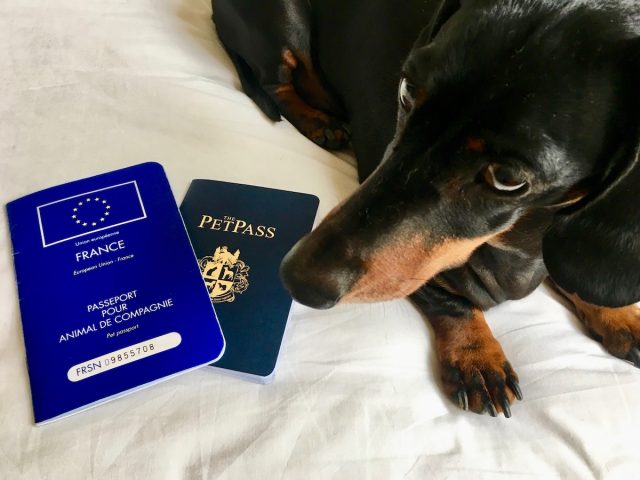
Finding a Pet-Friendly Airline to Fly to Europe
The next important step is finding a pet-friendly airline to fly yourself and your dog to Europe. Unfortunately, some airlines that normally allow pets to fly in cabin, don’t allow this on Transatlantic flights, in particular American airlines .
Flying with a US Airline
If you are wanting to fly with your dog in the cabin, not all American airlines permit this on Transatlantic flights. American Airlines clearly states in their pet policy that they don’t allow pets in the cabin on Transatlantic flights, due to the flight duration.

One American airline that definitely allows pets in the cabin on flights to Europe is Delta . For pets in the cabin, there is no maximum weight, just a maximum kennel size that depends on the flight (check at the time of booking). A charge of $200 USD applies and a maximum of four pets are allowed in the cabin. Read their pet policy .

For awhile, United Airlines also didn’t allow pets in the cabin on Transatlantic flights, but they are once again allowing pets on flights to Europe, except to Ireland, Sweden and the UK. If you fly with your pet in the cabin with United Airlines, a charge of $125 USD applies. There’s no maximum weight, just a maximum kennel size. See their full pet policy for in-cabin pets .
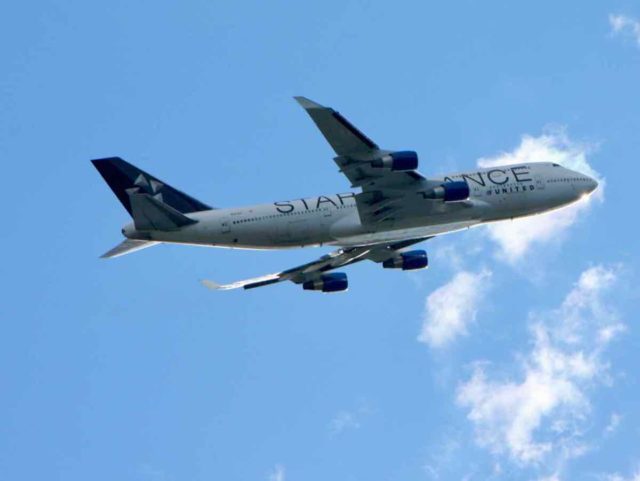
If your pet is too large to fly in the cabin, there are currently limited options for pets to fly in the hold on US airlines. Delta Cargo has not accepted bookings for pets since 2020, while United Airlines no longer accepts bookings through United PetSafe , although are some exceptions for active-duty US military and US State Department Foreign Service personnel travelling on official orders. I believe American Airlines Cargo currently accepts pet bookings.
Another alternative is to fly with Air Canada . Air Canada permits pets in the cabin on flights to and from Europe, with no maximum weight, just a maximum kennel size. See their pet policy .
Additionally, Air Canada is one of the few airlines that accept pets in the cabin and as checked baggage on flights out of the UK, instead of only as cargo, as is the case with Delta. (Although pets still need to fly as cargo on flights to the UK.)
Flying with a European Flag-Carrier Airline
In general, the European flag-carrier airlines are most likely to allow your pet to fly in the cabin with you to Europe. Based on discussions with other travellers flying from the USA to Europe with their dog, the most commonly recommended airlines are Air France, KLM and Lufthansa.
All three airlines allow dogs to fly both in the cabin and in the hold on their Transatlantic flights. Here are some details about each airline.

Air France: Dogs up to a maximum weight of 8kg (17lb), including carrier, are permitted in the cabin, with a fee equivalent to €200 (about $220 USD) charged. Note that pets are not permitted in business class on intercontinental flights. Dogs up to 75kg (165.3lb) are permitted in the hold, with a fee equivalent to €400 (about $440 USD) charged. It’s possible to buy travel containers for the cabin and hold directly off Air France for delivery to the USA. Read their full pet policy .
KLM: KLM also has a maximum weight of 8kg (17.6lb) for pets in the cabin and 75kg (165.3lb) for pets in the hold, including their carrier or crate. The charge for each pet depends on your departure and destination airport. Once again, pets are not permitted in business class on intercontinental flights, due to the seat design. Read their pet policy .
Lufthansa: Lufthansa also has a weight limited of 8kg (17.6lb) including carrier for pets in the cabin. For transport in the cabin, a fee of €100 ($110 USD) is charged to/from the East Coast, €110 USD ($120 USD) to/from the West Coast. Prices for pets in the hold depend on the crate size. Read their pet policy .
For information on the pet policies of more European airlines, check out my extensive guide, which details which European airlines allow pets in the cabin .
Flying with a European Business Class Airline
A recent addition to the list of dog-friendly airlines flying between the the USA and Europe, is business-class only airline, La Compagnie . This France-based airline offers up to two flights daily between New York and Paris, plus seasonal flights to Nice – perfect for flying a dog to France from the USA . Perks include full-flat seats (although read on…), complimentary high-speed wi-fi and fine cuisine.

The biggest advantage of booking your pet to fly on La Compagnie is that dogs and cats up to 33lbs (15kg) are allowed to fly with you in the cabin, far higher than the normal limits. They need to fly in an aerated pet carrier, with maximum dimensions of 21 ⅔ in x /13 ¾ in x / 9 ⅚ in (55 x 35 x 25 cm).
There’s a limit of one pet per passenger, with a maximum of three pets permitted on each flight. You’ll need to book your pet at least 48 hours in advance (online or via the call centre) and pay a fee equivalent to 10% of your own ticket.
The only downside? If flying with a pet, you can’t fully recline your seat. Plus they count as your item of cabin luggage, so you’ll only be able to bring a small personal item in addition into the cabin.
Flying with a European Budget Airline
Unfortunately, not many of the budget European airlines permit dogs to fly on Transatlantic flights, even if they permit dogs to fly on their flights within Europe. I found this to be problematic when I was flying one-way from Europe to the USA with my dog, and the flag-carrier airlines were mainly charging astronomical prices for one-way flights.
The main option I uncovered was XL Airways, a small airline that operated out of Paris, flying to and from New York, Miami, Los Angeles and San Francisco. However, XL Airways has now ceased operations, so there’s no budget airline options that I’m aware of.
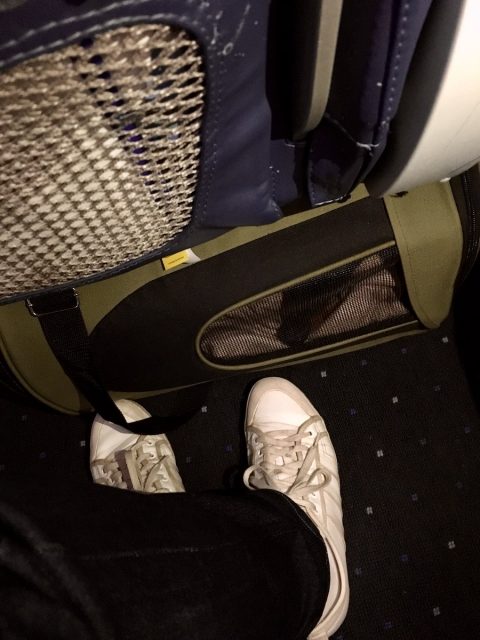
Try to Minimise the Flight Duration
Another consideration to keep in mind is the length of a flight. When I last flew from Europe to the USA with my dog, I purposely organised my travels to fly from Paris to New York, to minimise the flight duration. This is especially important if you want to fly with your pet in the cabin.
In order to keep your flight duration to a minimum, consider taking a connecting flight on either end. For example, firstly fly from the West Coast to the East Coast, before flying on to Europe. Also consider taking a second flight within Europe to get to your final destination. This is also an option if you don’t find a pet-friendly airline that flies directly to your final destination.
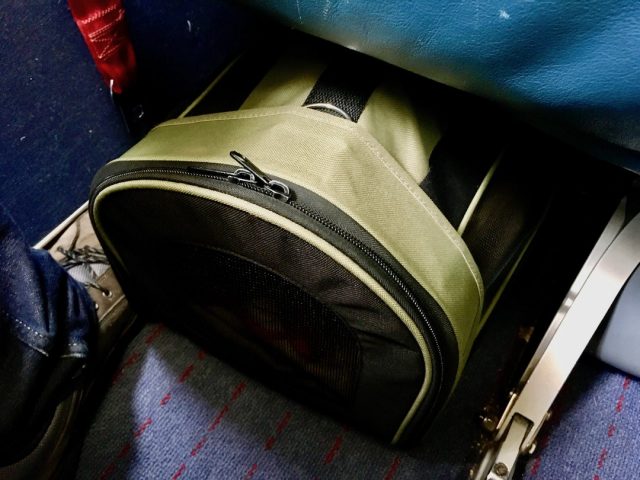
Choose the Time of Day Carefully
If flying with your animal in the hold to Europe during the summer months, keep in mind temperature restrictions may apply. Perhaps consider taking an overnight flight that departs late in the day then arrives early in the morning in Europe. Read more of my tips for flying with a dog in summer .
What About Emotional Support Animals?
There are now limited options to fly in the cabin of a plane with your dog as an emotional support animal. Generally your pet will now need to fly as a pet, either in the cabin if they are less than the weight limit (if applicable) or in the hold, and pay the appropriate fees.
Some European airlines previously allowed emotional support animals to travel in the cabin on flights to and from the USA, but not always on other flights in Europe. However, these policies have generally also disappeared.
Prefer to cruise rather than fly? Find out more about the kennels aboard the Queen Mary 2 Transatlantic Crossings
Preparing Your Dog for Their Flight to Europe
Preparing your pet for a long flight to Europe can be daunting, even if you have previously flown with your pet. Based on my experience flying with my dog multiple times on long flights, these are my tips:
- Adjust your pet’s meal times if required, feeding them at least a few hours before the flight, not immediately before it, in case of an upset stomach. Don’t give them too much to drink either.
- Take your dog to a pet relief area as close to the flight as possible, either immediately before boarding or before going through security. This is especially problematic at European airports which tend not to have designated pet relief areas. Generally you need to take your pet outside the terminal building to some grass.

- This is a little easier to handle if your dog has been trained to use puppy pads. Some other travellers travelling with a pet in the cabin report using the plane’s bathroom to give their dog a break mid-flight. My dog isn’t trained at this (although is fine to hold on for 8 hours, if given minimal fluids), plus those bathrooms are tiny!
- On the flight, dogs travelling in the hold should have a water container attached to their crate. In the cabin, feel free to give your dog some fluids, but don’t give them too much. Some other travellers use ice cubes.
- Get your dog used to their crate or carrier ahead of time, regardless of whether they are travelling in the cabin or hold. Hopefully your dog just falls asleep and sleeps for most of the flight. To aid with this, either give them a big walk beforehand or fly overnight, when they’d normally be sleeping.

- If your dog is travelling in the hold, sedation is not usually recommended. (Sedatives can affect your dog differently at altitude, plus there is no-one to assist if something goes wrong.) If you are concerned, speak to your veterinarian ahead of time, allowing time to test treatments. Most dogs cope better than you expect.
See also my guide to flying with your dog in the cabin in Europe and my tips for flying with a dog .
Returning to the USA with Your Dog
The process to return to the USA with your dog was previously quite simple. For full details, see this post . However, this has been complicated by the temporary restrictions in the USA on importing dogs from high-risk rabies countries, with has no end date yet for these restrictions.
Most countries in Europe are not high-risk rabies countries, so you still should be fine. The only European countries that are listed as high-risk for rabies are: Armenia, Azerbaijan, Belarus, Georgia, Moldova, Russia, Turkey and Ukraine. See the latest list .

Returning from Non High-Risk Rabies Countries
If you only visit countries that aren’t high-risk for rabies, you technically don’t require a rabies vaccination certificate to fly back to the USA. However, your airline may require a rabies certificate, such as United Airlines.
Your airline may also require a health or fit-to-fly certificate, that you you can get from any vet within Europe. Check with your individual airline about their requirements. Also double check if there are any state specific requirements.

Returning from High-Risk Rabies Countries
If you do visit a high-risk rabies country in Europe, you are fine to return to the USA, as long as your dog has a microchip, a valid US-issued rabies vaccination certificate and is at least 6 months old. They also need to be healthy on arrival and fly into one of the approved ports of entry .
If your dog does not have a valid US-issued rabies vaccination certificate, including if it expired while you were overseas, you will need to apply for a CDC Dog Import Permit . This includes if your dog visited any high-risk rabies countries in the last six month, not just if they are flying out of one back to the USA.
Returning from Italy
While most European countries don’t have any requirements for pets being exported out of the country, one exception is Italy. Pets flying out of Italy to countries outside of the EU, including to the USA, require a Pet Export Certificate.

You will need to visit a local veterinarian to obtain a certificate of good health, then within 48 hours visit the local ASL (Azienda Sanitaria Locale), who will check your pet’s health and rabies certificates and issue an export certificate, for a small fee. For full details, see this US embassy website .
You May Also Like
- How to Travel with a Dog to the UK from Outside Europe
- How Dog-Friendly Are Airports in Europe?
- Travelling with a Dog in Europe
About the Author

Shandos Cleaver is the founder of Travelnuity: Dog-Friendly Travel. She has travelled extensively with her Miniature Dachshund, Schnitzel, including to 33 countries across Europe, every state and territory of Australia except Tasmania, and 10 of the United States. She’s passionate about providing inspiration and information to others wanting to travel with their dogs, whether close to home or internationally.
Inspired? Pin this to your Pinterest board!
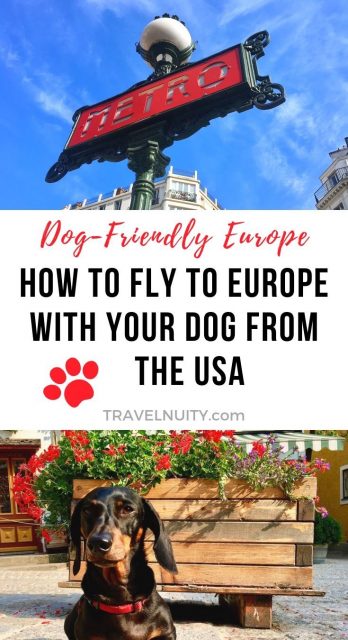
41 thoughts on “Flying to Europe with a Dog from the USA”
Excellent breakdown here. More folks fly with their pooches these days.
Thanks Ryan!
I heard airlines weren’t allowing dogs and cats on intercontinental flights anymore. Guess the rules have changed again. I think they banned all other support animals, which is good!!
Nice breakout! We’re moving to England with our pup and have completed most of these steps. Now to just make it through customs…
All the best with your move! Customs in Europe is usually fairly easy, but the UK checks are strict!
Thanks!!What about ? cat!? I am not sure is same traveling with cat ! I will be traveling with my cat at spring from Austin, TX to Zagreb Croatia! What l need to do here before travel.thanks!
Zee – Most of the same regulations apply for both cats and dogs. (Rules for more exotic pets vary by airline.) The main difference is that cats don’t require the worming that some dogs requires for countries like the UK. Enjoy your trip!
How did your trip turn out?? I plan to do the same trip to Zagreb.
We traveled to Europe for a month leaving our Irish setter, Snacks Mc Reilly, at our trainer’s pet lodge. He was less traumatized than we were. We are almost 70, yet dream of returning to Europe one more time. We continue to think about the Pilgrimage to Santiago. How beautiful to imagine walking the Camino with Snacks! The reality is, we live in Spokane, Washington, the Pacific Northwest. We are thinking the flights there and back would be both unusual and cruel. Shared thoughts and experiences would be most welcome, informing us of the truth, either way.
It would be amazing to walk the camino with your dog, but it’s not an easy decision to put them into the hold. For a long flight like that (or two flights), I would probably hold off unless you’re going to be in Europe for quite a while (longer than a month). Though it also depends on the age of your dog and whether they’ve flown before and how they’ve handled it.
Thanks for all the tips. However, american airlines does allow pets on flights to europe, not sure if they might have changed their policies since this was written.
Thanks Melinda! I will go over this and review the options, once the current travel lockdowns are over. A number of the US airlines have restrictions but have changed them multiple times, so it’s hard to keep up.
That’s what I’m wondering!! I heard recently, they weren’t allowing dogs, I guess that includes cats on international flights and had banned all other crazy animals in the USA.
I am getting ready to move from the USA to Italy for four years. I am taking my almost three year old; 125 pound Great Dane with me. He has never flown before. Any tips from seasoned fliers that have traveled with large dogs before? Thank you
I don’t have personal experience, so I recommend asking in my Facebook group: https://www.facebook.com/groups/dogfriendlytravelrtw . You may run into issues with maximum weights/sizes for dogs and their crates on some airlines, especially flying as checked baggage rather than cargo. To determine the size crate required, see: https://www.iata.org/en/programs/cargo/live-animals/pets/
I just completed a round-trip from the west coast USA to Athens, with a stop in Frankfurt. This blog and the reader comments helped me immensely, so I wanted to share my experience with others.
We flew Lufthansa with our 4kg dog in the cabin. We did not feed her any breakfast the morning of our departure, but took her out for a walk and pee as usual. Check-in was easy and quick with the USDA signed health certificate and rabies vaccination certificate. No one measured our travel crate at check-in, nor did they weigh it or our dog. Our flight + wait around to board time was 13 hours from SFO to Frankfurt. On the flight, I gave our dog a 1/2 a Trazadone and offered her tiny sips of water, which she refused to drink. Upon landing for our connection, we had a 2.5 hour layover. Not enough time to leave the airport and return because the security line at customs was backed up. Our dog would not go pee on the marble floor of the airport. We boarded our flight from Frankfurt to Athens, and I gave her another 1/2 Trazadone and offered her water, which she accepted. I took out a pee pad and placed it at my feet on this flight, and snuck her out of her carrier and gave her the “go pee” command. She refused. So, back in the carrier she went for the rest of the flight, and I took her outside as soon as we landed and collected our luggage. She finally peed, after a full 19 hours of travel. (There is a green grassy area just in front of the Sofitel at the arrivals exit door in Athens.) During both flights, I kept her on my lap in her carrier and pet her the whole time. They flight attendants were strict about my keeping her in her carrier- but I snuck her out when they darkened the cabin and she slept under a blanket on my lap for about 3 or 4 hours of the journey. The same thing took place on our return home other than (a) they weighed our dog and carrier upon check-in and (b) the USDA agent asked to see her rabies certificate as we exited the airport in our home town. Yes, our dog once again held her pee and poop for 19 hours! Overall, flying with her was MUCH easier than I expected, and the paperwork/verification was a breeze.
That’s great to hear, thanks for sharing! It’s surprising how long they can hold on, if there’s no grass to go on.
Hi Anne, how were you able to get the USDA Health Certificate? Were you able to do it online or you had to go to an APHIS office to get it? Headed to France in November, your comment has been very helpful!
This is a solid article. Thank you so much for putting it together. We are putting our place on the market and just going to travel Europe with pups in tow. 🙂
Thanks Uric, wishing you lots of fun!
Great article! My boyfriend and I have 2 golden retrievers, we don’t want to feel confined to road trips, thinking of Italy sometime this coming year…
Thanks Josselyn, enjoy planning your trip!
Great article! We also have a long-haired miniature dachshund. He’s one year old and has traveled with us in cabin inside the USA. We are now preparing for a trip with him to Italy. Before departing overseas, we are stopping to visit family in various US states. Can we get the USDA vet visit and certification done in one US state but then fly out of a different state?
I’m pretty certain that’s allowed, as some states don’t have a USDA office and many people take a domestic flight before an international flight. If you have any doubts, check with the USDA beforehand.
Hey Shandos,
thanks for the reply. The USDA was very informative and the answer is yes, you can get the certificate in one state and fly out of anywhere in the USA. Another question. In Italy were you able to get a Pet European Passport without being resident? From all i’m reading you have to be a resident.
I’ve recently had a comment left from someone who was also told that. Previously you didn’t need to be a resident, but since Brexit and an influx of Brits trying to get EU pet passports, some countries have cracked down on the rules (France and now Italy). It’s still worthwhile trying.
Hi! Thanks for all the info. If I fly into Spain with all my proper documentation, will I be able to then fly to Italy & spend 10 days with my dog there before returning to Spain? I think the answer is yes but thought asking you might be a good idea. Thanks!
Yes, that will be fine, assuming it’s within 4 months of you arriving in Spain. Just ask the customs official in Spain to stamp your dog’s paperwork when you arrive.
we just found out that KLm does not allow hold pets on their 787-9 or 787-10 planes any recommendation, we bought a small home in Holland and had planned to take our dog with us when we spend 4-5 months of the year there. have any info on cargo flights for dogs ?
I’m not fully across the airlines that allow dogs to fly in cargo across the Atlantic. I believe some of the US airlines don’t allow pets in cargo at the moment, but I recommend checking with other European airlines, such as Lufthansa. The downside will be a possible transit stop.
I just wanted to thank you so much for this information! It saved me days of research and trial and error. Thank you for all your work.
Glad I could help! I remember how little I knew before I first flew internationally with my dog.
Thank you so much, this is very very helpful! I am at my wits end trying to get my dog the EU passport. I have done the USDA certification for Italy a few times now and it is such a hassle with the 10 day limit for Italy and the costs. I’m hoping the EU passport alleviates these issues. However, the vets in Italy at the Azienda Sanitaria Locale say they won’t issue one if my dog has a US microchip. Is this true? Do you know any other way to get the EU passport?
My dog got issued one in France, but this was prior to Brexit when French vets started restricting issuing them unless you had residency. I wasn’t sure if vets in Italy were okay issuing them – can they actually tell the microchip is from the US? I wasn’t aware of that. Perhaps try a different vet in Italy? I’ve heard recent stories of Spanish vets issuing them, plus German vets tend to be okay, except they usually insist on a new rabies vaccine.
Thanks Shandos, I’ll share here if I find any useful information! Really appreciate you and your site and helpfulness 🙂
I am planning to flying from NYC in January 2024 to Portugal with my dog in Cargo. I will be spending at least a month in Southern Portugal. in the Algarve, then flying back to NYC in February. I read that I may not be able to fly with my dog at all during this time of year. Is this true?
Some airlines have restrictions on flying with dogs during the hot summer months, or when it’s very cold. However, I haven’t heard about it applying in New York City. This is airline dependent, so I recommend asking the airline.
Thank you so much for this article. I need to go to the UK for 3 months for work. We need to take our small dog. We can’t fly our dog in the cabin to the UK. I was advised to fly to Paris, France, with our dog in the cabin. Do we need health certificates for the EU and UK? Can we take a train to the UK if we fly to Paris? How long is our certificate good for in the UK if we can’t get an EU passport in France? All of this is so confusing. Do you recommend another way? Any insight you can offer would be greatly appreciated. Thank you!
Yes, you’ll need health certificates for both the EU and the UK. You won’t be able to take the train to the UK (no dogs on the Eurostar across the channel) – instead it’s easiest to take a pet taxi that goes on the Channel Tunnel, or there are a few pet-friendly ferries (Dieppe to Newhaven, Hook of Holland to Harwich, Amsterdam to Newcastle). Once you are in the UK, there is no issue with expiry date of the certificate, as long as you stay in the UK. You may need new certificates for the return trip, depending on what route you take.
Two other options to consider, in addition to flying to Paris, is to fly to Amsterdam (particularly if you want to take one of the ferries from the Netherlands) or to fly to Dublin, although not as many airlines fly to Dublin with pets in the cabin. However, from Dublin there’s plenty of dog-friendly ferries across to Wales, then the trains in the UK are pet-friendly.
Shandos thank you for all the great info. I am in the US and would like to travel around Europe for a few months with my wee Westie. If I rent/lease a car what should I expect when entering a country with my pup by vehicle? Thanks!
If you’re driving between countries in the Schengen zone, don’t expect any checks at the border, either on your own passport or your dog’s paperwork. However, do check in advance with your rental company which countries you can drive in (particularly in the east where not all countries are in the EU there may be restrictions). Plus, many countries have a “vignette” sticker to drive on the motorways, so check what’s on the car and whether you need to buy one for cross-border excursions. Your rental car company should be able to help you out.
Leave a Comment Cancel reply
Save my name, email, and website in this browser for the next time I comment.
- International Travel
- Travel Tips
- Personal Finance

Travelling to or returning to Europe with your pet?

Pets, i.e. dogs, cats or ferrets travelling to or returning to EU Member States must be must be accompanied by
- an animal health certificate according to the model provided in Part 1 of Annex IV to Regulation (EU) No 577/2013 as last amended by Regulation (EU) 2019/1293 . completed and issued by an official veterinarian, or by an authorised veterinarian and subsequently endorsed by the competent authority
- documenting the alpha-numeric code displayed by the transponder or the tattoo, the details of vaccination against rabies, the details of the blood sampling, and where applicable, the details of the treatment against Echinococcus multilocularis
- Laboratories authorised in EU countries and in Non-EU countries for verifying the effectiveness of rabies vaccination on dogs, cats and ferrets entering an EU country (including in China) are listed here: https://ec.europa.eu/food/animals/pet-movement/approved-labs_en
Find a courtesy translation EN/CN version for your Chinese veterinarian: EN CN
2. a written declaration completed by the owner or an authorised person regarding the non-commercial nature of the movement and attesting, where appropriate, the carriage of the animal under the responsibility of an authorised person within up to five days of the movement of the owner.
Find a courtesy translation EN/CN version of the model in Part 3 of Annex IV to Regulation (EU) No 577/2013 )
written_declaration.docx
For more information consult: https://ec.europa.eu/food/animals/pet-movement/eu-legislation/non-eu-imports_en
- Share full article
Advertisement
Supported by
Flying With Dogs or Cats? These Are Airlines’ Pet Policies
American recently relaxed its rules for pets traveling inside the cabin with their owners. Here’s what the major U.S. airlines require to travel with a pet.

By Jesus Jiménez
Flying with a pet can be expensive and confusing, with fees, weight limits, carrier size rules and the need to make sure there’s no loud barking (or meowing) on board.
Recently, American Airlines relaxed its pet policy to allow passengers to bring a carry-on bag in addition to a pet in a carrier, and more private flight options have been emerging in recent years for pet owners who can afford them.
Still, flying with large or medium-size dogs can be tricky, and many travelers are wary of leaving a pet in the plane’s cargo hold.
For those traveling on the major carriers with their pets as carry-ons, here’s what to know about each major domestic airline’s policy.
Southwest Airlines
On Southwest, a Dallas-based carrier, two checked bags can fly at no cost, but not pets. Southwest charges $125 per pet carrier on its flights.
Dogs or cats are allowed to travel below a seat in an approved carrier — up to 18.5 inches long by 8.5 inches high and 13.5 inches wide — according to the airline .
Southwest has a few caveats for those traveling with pets: The pet must stay in its carrier during the flight, and the carrier is considered a personal item or carry-on bag.
Up to six pets are allowed on Southwest flights. Once six pets are booked onto a flight, no further customers may add a pet companion to their booking.
United Airlines
United Airlines has no weight or breed restrictions for cats and dogs as long as they are in an approved hard or soft-sided carrier, measuring 17.5 inches long by 9 inches tall and 12 inches wide for a hard carrier, or 18 inches long by 11 inches tall and 11 inches wide for a soft carrier.
United charges $125 each way for travel with pets. There is no fee for service animals on United flights, but some forms are required before the flight.
The carrier must fit under a seat, and where a passenger is allowed to sit can vary according to the type of aircraft. For example, people traveling with pets cannot sit in emergency rows. If you’re traveling with two pets (the maximum allotted), you are required to book two seats.
Delta Air Lines
Small dogs and cats can travel on Delta Air Lines flights as long as they can fit inside a carrier stored below the seat. The size of the carrier depends on the aircraft, but in general the airline recommends a soft-sided carrier no larger than 18 inches long by 11 inches tall and 11 inches wide.
Your pet must be at least 8 weeks old and small enough to have some room to move around in the carrier, which must have ventilation openings on three sides.
Delta charges $95 for pets traveling as carry-on companions, and the passenger can bring only one personal item along with the pet. Certain seats cannot be booked for travel with an animal, such as those in an emergency exit row.
American Airlines
American Airlines allows cats and dogs to travel in a carry-on container, which must remain under the seat in front of the pet owner throughout the flight. The airline recommends a soft-sided carrier that measures 18 inches long by 11 inches tall and 11 inches wide.
The fee for a carry-on pet on a domestic American Airlines flight is $150.
Flights are limited to seven carry-on pets, not including service animals, and American Eagle flights are limited to five carry-on pets, with one in first class. There is no charge for service animals flying on American flight, but the airline requires forms to be filled out in advance.
The airline said in a statement that it had recently changed its cabin pet policy to allow customers with a pet to also bring either a personal item or carry-on bag stowed in the overhead bin (but not both).
“We made the change to provide a more convenient and comfortable experience to customers whose pets fly American,” the airline said.
Spirit, JetBlue, Frontier and Alaska
Spirit allows dogs and cats on its flights in a carrier no larger than 18 inches long by 14 inches wide and 9 inches tall for a fee of $125. The weight of the pet and the carrier cannot exceed 40 pounds, according to the airline .
Small dogs and cats can fly on JetBlue for fee of $125 each way , in an approved carrier. Up to six pets are allowed on JetBlue flights.
Frontier allows pets on board for a $99 fee each way, as long the pet fits in a carrier. Passengers can have only a personal item or carry-on in addition to their pet carrier.
Pets can travel in a carrier on Alaska Airlines flights for a fee of $100 each way. A passenger can travel with a pet carrier and a personal item, or a carrier and a carry-on bag.
Private or charter flights
Those who take their pets on private or charter flights, which can cost many thousands of dollars, have much more leeway. Dogs that weigh less than 150 pounds can sit on seats.
BarkAir, a charter operator tailored specifically for those flying with dogs, charges about $6,000 for a dog and its owner to travel, with flights between New York and Los Angeles and New York and London. Carriers are not required, and dogs can sit on laps, seats or beds.
Jesus Jiménez covers breaking news, online trends and other subjects. He is based in New York City. More about Jesus Jiménez
Open Up Your World
Considering a trip, or just some armchair traveling here are some ideas..
52 Places: Why do we travel? For food, culture, adventure, natural beauty? Our 2024 list has all those elements, and more .
Mumbai: Spend 36 hours in this fast-changing Indian city by exploring ancient caves, catching a concert in a former textile mill and feasting on mangoes.
Kyoto: The Japanese city’s dry gardens offer spots for quiet contemplation in an increasingly overtouristed destination.
Iceland: The country markets itself as a destination to see the northern lights. But they can be elusive, as one writer recently found .
Texas: Canoeing the Rio Grande near Big Bend National Park can be magical. But as the river dries, it’s getting harder to find where a boat will actually float .
STARS AND STRIPES
- Middle East
- Asia-Pacific
- Map Of Memorials
- Entertainment
- - Video Games
- Europe Travel
- - Quick Trips
- - After Hours
- Pacific Travel
- The Meat and Potatoes of Life
- U.S. Travel
- Storm Tracker
- Rewards for readers
- Get Stripes
- Stripes Lite
- Archives/Library
- Special Publications
- Mobile Apps
- Email Newsletters
- Digital Access
- Home Delivery
- Marine Corps
- Coast Guard
- Space Force
- Archive Photo Of The Day
- - Military Matters
- - Force For Hire
- Out of Uniform
- Communities
- Stripes Europe
- Stripes Guam
- Stripes Japan
- Stripes Korea
- Stripes Okinawa
- Our Other Websites
- In Memoriam
- Month of the Military Child
- Best of Germany
- Best of the Pacific
- Letters to Santa
Your Community
April adoptable pet of the month, tiffany.

Tiffany the Cat (KMC Adopt Don’t Shop)
Are you looking for a new furry friend for the family? We’ve partnered with KMC Adopt Don’t Shop to let you know about a pet that is looking for a new home.

Hello, my name is Tiffany
I am 2 to 3 -years-old
I am a Domestic Shorthair
I have been in my foster home for a few months and before that, I was a stray cat.
My favorite things are food and cuddles .
I would do best in a home with no kids , no dogs , but, perhaps, another kind and chill cat .
I would love a home where my family will love me and let me warm up to you slowly as I can be shy at first!

Click here if you are interested in adopting me.
related stories
- March Adoptable Pet of the Month, Orisa
- Adoptable Pet of the Month: Tyrone
- March 2024 Pet of the Month
The best stories from EUROPE, in your inbox
Sign up to receive travel tips, local event details, restaurant reviews, recipes, community news, and more every week from Stripes Europe.
Sign Up Now
Watch CBS News
Flying with pets? Here's what to know.
By Anne Marie Lee
Edited By Alain Sherter
Updated on: April 6, 2024 / 10:08 AM EDT / CBS News
Thinking of taking your dog or cat with you the next time you fly? For a growing percentage of the 90.5 million pet owners in the U.S., the answer is yes. But while the notion of boarding a plane with your pet may seem simple, the rules and restrictions around traveling with an animal can be confusing.
Eight major U.S. airlines allow pets to fly in-cabin as carry-ons. But flying with your pet takes research and planning, as pet policies vary from airline to airline, are steeped in restrictions, and are limited to specific countries and cities. You'll also have to pay an extra fee for your pet ranging from $95 to $200, depending on the airline and where you're flying. And restrictions often change.
For example, American Airlines recently revised its policies so passengers flying with pets may also bring one full-size carry-on or personal item. But the carrier prohibits carry-on pets on transatlantic and transpacific flights. Here's what you need to know when considering taking your fur baby with you on a plane.
Cargo, check-in or carry-on?
Most airlines offer three options for transporting animals: cargo, check-in or carry-on. But if your pet is larger than a bread box, your options are limited to the cargo or baggage check-in options, with very few exceptions.
Given that large canine breeds such as Labrador Retrievers, German Shepherds and Golden Retrievers are among the most popular dogs in the country, the size restriction for in-cabin pet travel can be a major frustration for those who would rather not fly at all if that means putting their pet in cargo.
A 2023 Forbes Adviser survey of 10,000 U.S. dog owners found that 33% of respondents fly with their pets, while 37% listed not being able to bring their dog on a plane as their biggest annoyance. (You can learn more about the differences between cargo, check-in and carry-on options here , including warnings about the dangers involved when pets travel in the cargo hold.)
Carry-on pets
Even for pet owners whose animals are small enough to fly as a carry-on, traveling is no breeze.
"When I fly with him I have to go to the desk," Margaret Rauch, 44, told CBS MoneyWatch, referring to her 15-pound poodle mix, Soda. The New York City resident has taken Soda on dozens of flights to St. Croix in the U.S. Virgin Islands, where Soda, now 4, was being fostered by a friend after being found as a stray puppy in 2021.
In addition to calling the airline in advance to register her dog for a flight, Rauch has to check in at the counter whenever she's traveling with Soda, so the airline agent can confirm her dog and pet carrier conform to the in-cabin pet requirements and that the flight hasn't already met its pet maximum.

Rauch, who said she would never consider putting Soda in cargo, applauded American Airlines' new policy, while noting that in her experience the one carry-on rule was rarely enforced.
"I feel the price is already high for what I get. Even with AA's rule change, I lose the underseat space," she said. "My dog creates no extra work for anyone."
Despite the added preparation, paperwork and hassle involved in flying with Soda — not to mention the unfriendly looks she occasionally detects from fellow passengers at the sight of her pet carrier — Rauch said, "It's absolutely worth it."
Asked how the experience could be improved, she pointed to early boarding for pet owners as something that would help.
"If you can get in early, get a seat and settle down, that is an accommodation I don't expect to see anytime soon but I think it makes sense," Rauch said.
Safety and comfort
For the many Americans who see their pets practically as family members, one of the most challenging aspects of flying is ensuring their animal's comfort and safety.
"The increasing humanization of pets, which involves treating them as part of the family rather than as mere animals, has increased the demand for pet travel services that are of high quality and can be customized to meet the specific needs of each pet," LinkedIn reported in December.
Among other tips, the U.S. Department of Transportation and animal experts recommend that you not feed your pet four to six hours before a flight and limit their water intake. Others also suggest keeping bottled water on hand at all times. Additionally, most airlines require certain vaccination and vet certification that your pet is healthy enough to fly. Individual countries also have their own requirements for pets to enter.
Not surprisingly, some airlines do better than others at handling pets. One of the best-rated carriers for pet travel is Alaska Airlines, which has repeatedly topped rankings, such as NerdWallet's Most pet-friendly airlines of 2024. In recent years, the airline also has maintained one of the industry's lowest incident ratings, according to Veterinarians.org. United Airlines and Delta are among the airlines with the highest incident rates, according to the pet information website.
On Rauch's first plane trip with Soda traveling home to New York, a layover in Miami led to the flight sitting on the tarmac for two hours. Calming treats are something that helps keeps her dog relaxed on flights. She also withholds Soda's food and limits his water intake up to five hours before a flight, which is also helpful given that he doesn't like using pet relief areas, which she said generally smell of urine and can be overwhelming for dogs. Flights between New York City and St. Croix are generally under six hours.
"I'm not sure how I'd handle a flight to Singapore," Rauch said.
Here's a rundown of U.S. airlines' pet travel policies, along with fees and and restrictions:
Alaska Airlines
Pet fee: $100
Pets allowed: Dogs and cats are the only pets allowed in-cabin on international trips and flights to Hawaii. Domesticated rabbits and small household birds are allowed as carry-on on domestic flights.
Destinations: Domestic and international, with additional requirements and documentation required for pets traveling to Hawaii or internationally .
See Alaska's full pet policy here .
American Airlines
Pet fee: $150
Pets allowed: Dogs, cats
Destinations:
- Within the 48 contiguous U.S.
- The U.S. and Canada*
- Puerto Rico
*Additional special restrictions may apply. See American's full pet policy here .
Pet fee: $75-$200, depending on destination
Pets allowed: Dogs, cats, household birds
Pet friendly destinations:
- U.S., Virgin Islands and Puerto Rico
- International destinations with the exception of Australia, U.K., Republic of Ireland and others .
Pets are not permitted on flights to Hawaii. See Delta's full pet policy here .
Frontier Airlines
Pet fee: $99
Pets allowed: Dogs, cats, rabbits, guinea pigs, hamsters and household birds
Destinations: Domestic flights and international flights to and from the Dominican Republic and Mexico.
See Frontier's full pet policy here .
Pet fee: $125
Destinations: Domestic and international. See exceptions for international flights here .
See JetBlue's full pet policy here .
Southwest Airlines
Pet fee: $125 per pet carrier on the U.S. mainland; $35 per pet carrier between Hawaiian Islands
Destinations: Domestic U.S. flights only. For travel to Puerto Rico, specific requirements may apply . For Hawaii travel, see rules and regulations here.
See Southwest's full pet policy here .
Spirit Airlines
Pets allowed: Dogs, cats, birds (with the exception of flights to or from Puerto Rico and the U.S. Virgin Islands) or rabbits (with the exception of flights to or from Puerto Rico and the U.S. Virgin Islands).
Destinations: Domestic flights including Puerto Rico and St. Thomas, U.S. Virgin Islands
See Spirit's full pet policy here .
United Airlines
Destinations: Domestic and international flights with a list of exceptions. United does not allow pets to fly to, from or through certain states and countries. View the list here .
See United's full pet policy here .
More from CBS News

5 important debt relief options to know

Owe back taxes on April 15? Here's how tax relief can help now.

Are gold bars and coins worth it with inflation on the rise?

7 best bank account bonuses for April 2024 (up to $600)

American Airlines' Dog Policy: 5 Things To Know
- American Airlines allows carrying a dog or a cat in the cabin, though it must meet size, age, and destination restrictions.
- The US-based legacy carrier accepts a maximum of seven kennels in the cabin, while the regional subsidiary, American Eagle, only allows five.
- Besides the kennel, passengers are only entitled to another personal item, but no carry-on bag.
Some say that solo travel is the best way of exploring the world while reconnecting to our inner selves. Some others would never embark on an adventure without their travel buddy, and finally, we find those who love travel groups, whose motto is "the more, the merrier." However, airlines should not forget about another fundamental group of travelers, i.e., those who do not want to leave their pets behind. Indeed, increasingly, more people do not want their furry friends missing from the holiday portrait, which means they might need to bring them on a plane.
However, not all airlines have the same rules for carrying pets, which, on the one hand, is not welcoming news for airport staff dealing with customers at check-in desks. Neither is it for the customers, who must go through airline websites repeatedly to get all the information they need to ensure their cute travel companions reach their final destination. Simple Flying has put together five must-knows if you are planning a trip with American Airlines and are thinking of bringing your pets along.
Which Rules Surround Taking Pets On Airplanes In 2023?
It's raining flying cats and dogs, american airlines only allows cats and dogs in the cabin.
First things first, you should know American Airlines only allows cats and dogs in the cabin. Therefore, if you have any other kind of pet, say, a guinea pig, they won't be allowed in the cabin with this carrier. According to the airline's rules, a cat or a dog can be carried in the cabin as long as they meet size, age, and destination requirements. Should these conditions be met, the pet can be taken on most flights lasting up to 12 hours and on those to or from the following locations:
- The 48 contiguous United States.
- The United States and Canada.
- Puerto Rico.
- St. Croix, US Virgin Islands.
- St. Thomas, US Virgin Islands.
On American Airlines' flights, passengers are allowed to bring one kennel onboard, provided that they have paid the carry-on pet fee and that the pet stays in the kennel, which must be placed under the front seat for the entire flight. Additionally, the kennel substitutes the carry-on bag if a pet is carried in the cabin. Therefore, passengers are only entitled to bring one personal item besides the kennel.
Flying your pet at all costs
The pet in cabin fee is $125 each way.
If you're traveling on a budget, you might want to double-check how much you will be charged to carry your furry friend in the cabin with you.
American Airlines charges its passengers willing to bring their pet in the cabin a $125 fee each way. Additionally, if you're flying domestically with a voluntary stop-over at one of American's hubs lasting more than four hours, you'll incur an additional $125 charge. Besides this cost, you might want to become an expert with aircraft types, as pets are not allowed on every plane in the American Airlines fleet. Indeed, because of a lack of under-seat storage, pets are not permitted on the following aircraft types:
- Boeing B777-200
- Boeing B777-300
- Boeing B787-8
- Boeing B787-9
As you're paying quite a sum to make your furry friend fly with you, you want to ensure they are fit to board a plane. When the carrier is American Airlines, this means the pet must not have been sedated. Indeed, according to the American Veterinary Medical Association (AVMA), pets that have been given sedatives or tranquilizers incur a higher risk of respiratory or cardiovascular problems at higher altitudes.
Let's talk numbers
From kennel size to maximum number of pet in cabin per aircraft.
To make things easier for its passengers, American Airlines publishes the maximum number of pets allowed in the cabin for each flight.
On its mainline flights, American Airlines only allows seven kennels, even though service animals do not count toward this limit. American Eagle, the carrier's regional subsidiary, only accepts a maximum of five kennels per flight. Regarding the kennel, the airline allows soft-sided and hard-sided carriers. For the latter, the size requirements vary based on whether you're flying American Airlines or American Eagle.
On American Airlines' flights, hard kennels should not exceed the following size:
- 19 inches by 13 inches by 9 inches (48 cm by 33 cm by 22 cm)
On American Eagle flights, measures for the kennel change to the following:
- 16 inches by 12 inches by 8 inches (40 cm by 30 cm by 8 cm)
If it is the first time you are carrying your pet in the cabin, and you still have to purchase a kennel, American Airlines recommends a soft-sided one, whose measures are:
- 18 inches by 18 inches by 11 inches (45 cm by 45 cm by 28 cm)
Checked pets
Not all pets are allowed as checked pets.
For now, if your furry friend does not meet the requirements to travel in the cabin, you are most likely not allowed to make them fly as checked baggage on your flight.
Indeed, American Airlines currently only accepts checked pets for active-duty US military and US State Department Foreign Service personnel traveling on official orders. Up to two pets can be checked, and these must always meet the destination's minimum age and health requirements. In case you are checking a pet, you are required to provide a health certificate, which must be issued by a vet within:
- Ten days of departure
- 60 days of return (for travel on the same ticket)
- Ten days of return (for travel on separate tickets)
Suppose your pet does not qualify for cabin travel or as a checked pet. In that case, you might consider shipping it to your final destination through the American Airlines PetEmbark program, whose specifics are illustrated in the video below.
Temperature restrictions
These ensure the well-being of the pets.
Let's not forget that we constantly look for comfort when we travel. So would a pet. Therefore, American Airlines mandates some temperature restrictions to ensure its well-being while onboard.
These restrictions are mainly aimed at ensuring that checked pets and pets traveling in the cargo section are not exposed to extreme hot or cold temperatures at the following touchpoints:
- The animal holding area
- At terminal facilities
- When moving animals between the terminal and the aircraft
- On the plane
If the current or forecasted temperature at any location of the itinerary is above 85 degrees Fahrenheit (29.4 degrees C), the pet is not allowed to fly. Additionally, pets that are not traveling in the cabin cannot fly to, through, or from Phoenix (PHX), Tucson (TUS), Las Vegas (LAS), or Palm Springs (PSP) between May 1st and September 30th. On the other hand, pets are not allowed if the current or forecasted temperature at any location of the itinerary is below 45 degrees Fahrenheit (7.2 degrees C).
The cold temperature limitation can be waived if you hold a written letter from a vet including the following points:
- Your name and address
- Your pet’s name
- Your vet’s name and signature
- Your vet’s accreditation date and number
- The temperature your pet is acclimated to
Additionally, the letter must be issued:
- Within 10 days of the first flight
- Within 30 days of any other trips in the same itinerary
However, should the temperature drop below 20 degrees Fahrenheit (-6.6 degrees C), the pet is not allowed to fly even with a letter from the licensed vet.
Have you ever flown with your pet on an American Airlines flight? Let us know by clicking on the comment button below!
American Airlines
IATA/ICAO Code: AA/AAL
Airline Type: Full Service Carrier
Hub(s): Charlotte Douglas International Airport, Chicago O'Hare International Airport, Dallas/Fort Worth International Airport, Los Angeles International Airport, Miami International Airport, New York JFK Airport, LaGuardia Airport, Philadelphia International Airport, Phoenix Sky Harbor International Airport
Year Founded: 1926
Alliance: oneworld
CEO: Robert Isom
Country: United States
Airline Group: American Airlines Group
Region: North America
Loyalty Program: AAdvantage
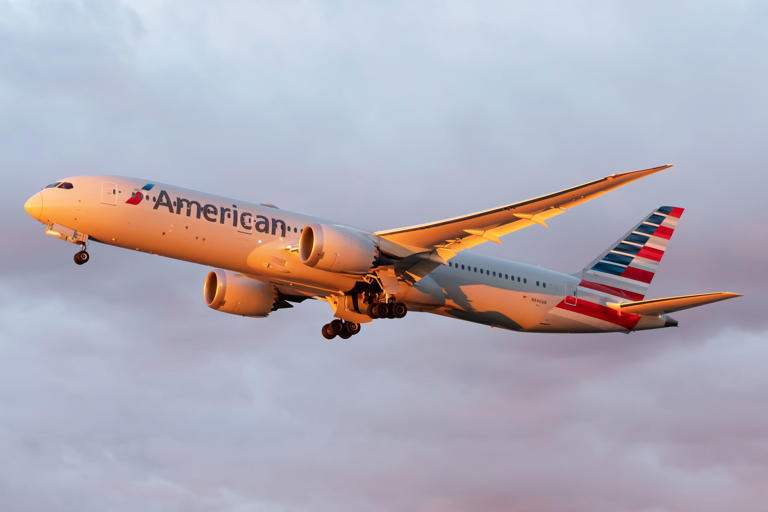
The world's first doggy jet service will cost you $6K for a one-way ticket

Dogs will soon be able to experience their own “ fur st” class flight with the launch of the world’s first jet charter company specifically designed for man’s best friend.
BARK, the dog toy company that coordinates the popular treat subscription BarkBox, is partnering with a jet charter service to take away the challenges of long-distance traveling with dogs, according to a press release. BARK Air, as the company calls it, offers the “white glove experience typical of a human’s first-class experience and redirected all that pampering to pooches.”
Taking dogs on airplanes is, typically, a stressful endeavor with different airlines having different policies for pet travel. For example, American Airlines allows small dogs in a carrier to be placed under the seat in front, but larger dogs are put in the cargo space, which has been found to be stressful for the pet. For United Airlines , pets can fly in the cabin if there’s enough space, but they must fit in a carrier under the seat in front.
“We are excited to take the insights we’ve learned over years to create an experience that is truly dog-first, which is drastically different from just accepting dogs – from the ground to the skies,” said Matt Meeker, Co-Founder and Chief Executive Officer at BARK, in a statement.
First-time Fido's taking to the sky? Here are tips from my flight with a dog
Learn more: Best travel insurance
However, you’ll need to pay a hefty fee for the dog-friendly flight. For now, a ticket for just one dog and one human will run you at least $6,000 one way.
The first BARK Air flights will take off on May 23, and so far, there are only two flight routes available, both from New York’s Westchester County Airport. From New York to London’s Stansted Airport, it’ll cost $8,000 one-way and to Los Angeles’s Van Nuys Airport will cost $6,000 one-way. Tickets are available for purchase on April 11.
Not only does BARK Air allow dogs, it also focuses on the furry friends by treating them like VIPs, the press release said. BARK Air passengers can skip TSA checkpoints and screenings and instead experience a simple check-in process where they can meet the other dogs on the flight and the humans are served a meal cooked by on-site chefs.
When boarding, a BARK Air concierge is on-hand to ensure the dogs are socializing and adjusting to the environment well.
Each flight will undergo “Dogs Fly First” flight prep that includes “calming pheromones, music, and colors that pups prefer.” To make the flying experience easier and more enjoyable, dogs have access to various aids such as calming treats, noise-canceling ear muffs, and calming jackets.
During takeoff and descent, dogs are given a beverage of their choice to help their ears adjust to cabin pressurization. Of course, there will be plenty of treats on the flight.
Kathleen Wong is a travel reporter for USA TODAY based in Hawaii. You can reach her at [email protected] .

IMAGES
COMMENTS
Having an EU pet passport eliminates this step and allows Poppy to travel freely to EU countries — as well as Switzerland, Norway and much of the Balkans — for the next three years. This is a great cost-cutting measure for travelers who frequently visit Europe with a pet. Getting an EU passport for Poppy in Spain was much easier than I ...
It really all depends on when you're traveling and where you're traveling to. However, bringing your dog on a flight in the cabin usually costs around $125 to $250. Whereas transporting them in the cargo hold can usually be well over $1,000. For international pet shipping, licensed companies usually charge between $1,000 and $6,000.
Travelling with more than 5 pets. You cannot take more than 5 pets to an EU country or Northern Ireland unless you're attending or training for a: competition. show. sporting event. You'll ...
Pets travelling without their owner. As a rule, pets must travel with their owners; however, you may give written permission to another person to accompany your pet for you (this written declaration is described above). You must however be reunited your pet within 5 days of its relocation. If your pet is travelling unaccompanied, it will have ...
Before traveling to Europe, you must vaccinate your pet against rabies by an authorized veterinarian. Your pet must be at least 12 weeks old at the date of vaccination. The period of validity of the vaccination starts 21 days from the completion of the vaccination protocol for the primary vaccination. Rabies Antibody Test
It's essential that the microchip is implanted before the rabies vaccine is given, so you cannot really do it all in one go. A rabies vaccine given prior to microchip insertion is invalid and your pet won't be able to travel. For Europe specifically, your pet must have an "ISO 11784/11785 compliant 15 digit microchip". I'm saying ...
Europe is largely rabies free, although wildlife-mediated rabies still occurs in some countries, including in the EU. Due to this, it's a requirement that your dog is vaccinated against rabies before travelling to the EU. If you're vaccinating your dog for the first time, it must be completed at least 21 days before arriving in the EU (plus ...
EU Regulation on the rules for travelling with pet animals in the EU or to the EU from a territory or non-EU country. Commission implementing Regulation on the model identification documents for dogs, cats and ferrets including the lists of territories and third countries, and the format and language requirements of the compliance declarations ...
EU Regulations for Traveling with Pets. Traveling with your pets within Europe, specifically, within the European Union, can be a seamless experience, provided you adhere to the established regulations. The EU has specific rules that make it relatively straightforward to travel with your dog, cat, or ferret. These regulations are designed to ...
Therefore, you must be aware of the criteria you must meet for your pet to travel with you. If an airline allows pets in the cabin, usually the animals must: Be a well-behaved cat or dog. Weigh less than 7-9kg. Comfortably fit in a soft or hard-sided carrier within specific dimensions that can be placed under the seat.
3. Check-in counter. At the check-in counter, the airport worker weighs the carrier with a pet inside and gives the owner a ticket to pay. A person can't get a boarding pass without paying a fee that varies depending on the animal and the airline company. 4.
The 10 Tips for Traveling With a Dog to Europe. 1. Research the Destination Country's Travel Policy. Image Credit: Kampus Production, Pexels. Before you start booking flights, make sure to familiarize yourself with your destination country's pet travel laws. If you're going to a country that is a member of the European Union, you can ...
Here are some simple steps that will get you and your dog safely, legally, and happily to Europe. 1. Make sure your dog is healthy, microchipped, and ready for travel. To travel internationally with your dog, you'll need to get an international standard microchip (HomeAgain is a common brand) and make sure your dog is up-to-date on his or her ...
Before taking their dog, cat or ferret to the EU for the first time after 1 January 2021, pet owners must complete the following steps. The only new requirement for travel to the EU is the use of ...
For full details, check out my guide to travelling between European countries with your dog.I also cover the likelihood that your pet's paperwork will be checked. Reconsider These European Countries.. While Europe deservedly has a reputation as a great dog-friendly destination to visit with your dog, there're some parts of Europe that aren't so dog-friendly, especially compared to the ...
Traveling with your pet to Europe isn't all that complicated, however it does require some advanced planning and requirements differ among countries that are within the EU opposed to those that are not. For the sake of simplicity, this post will focus on the pet entry requirements for the European Union. We will note exceptions for travel to ...
The Windsor Framework. The adoption of harmonised rules on travelling with pets has made it easier for EU citizens and their dogs, cats or ferrets to enjoy the freedom of movement within the Union. This significant step was made possible by dramatic advances made in the fight against rabies. For movement between EU countries or from non-EU ...
If you are thinking of taking your dog to Europe, I've got you covered with this step-by-step guide. This is a guest post from Gigi Chow, the creator behind the international dog travel blog Wet Nose Escapades. Since 2016, she has flown her ultra-bossy Yorkshire Terrier Roger Wellington on over 60 flights across 24 countries, spending most of ...
Multiple European airlines will fly dogs in the cabin to Europe. Air France: Dogs up to a maximum weight of 8kg (17lb), including carrier, are permitted in the cabin, with a fee equivalent to €200 (about $220 USD) charged. Note that pets are not permitted in business class on intercontinental flights.
Pet travel schemes have been more flexible yet intricate over the years. One of the best parts about traveling to Europe with pets is that often you don't require tedious paperwork and make vet appointments. Nevertheless, there are some guidelines that you need to follow. Step 1: Microchip. Your pet needs to have a microchip or a transponder to ...
14.08.2020. Brussels. Pets, i.e. dogs, cats or ferrets travelling to or returning to EU Member States must be must be accompanied by. an animal health certificate according to the model provided in Part 1 of Annex IV to Regulation (EU) No 577/2013 as last amended by Regulation (EU) 2019/1293. completed and issued by an official veterinarian, or ...
Find out if your pet qualifies to travel. Your animal doesn't qualify for pet travel and is subject to different import regulations and export regulations if you: Don't see your pet listed below. Are exporting semen or embryos from any animal. Have a pet that's considered livestock or poultry, like pigs or chickens.
Traveling internationally with your pet can be a great experience. For one, most of us consider our pets family, so exploring the world or vacationing with our quadrupedal companion can be an ...
Pet Travel to a foreign country can be complex and time-consuming. Before you start the process, you will need to know the following: the type of animal traveling, the destination country, the date of departure from the United States, and whether or not the pet will be traveling alone, as cargo, or with a person in the cabin of the plane.
Pets can travel in a carrier on Alaska Airlines flights for a fee of $100 each way. A passenger can travel with a pet carrier and a personal item, or a carrier and a carry-on bag.
We've partnered with KMC Adopt Don't Shop to tell you about a pet that is looking for a home. This month, it's Tiffany. ... Europe Travel - Quick Trips - After Hours - Events; Pacific Travel - Quick Trips - After Hours ... The best stories from EUROPE, in your inbox. Sign up to receive travel tips, local event details, restaurant reviews ...
American Airlines passengers can now bring a pet, full-sized carry-on 00:33. Thinking of taking your dog or cat with you the next time you fly? For a growing percentage of the 90.5 million pet ...
Flying your pet at all costs The Pet in Cabin fee is $125 each way. If you're traveling on a budget, you might want to double-check how much you will be charged to carry your furry friend in the ...
Learn more: Best travel insurance However, you'll need to pay a hefty fee for the dog-friendly flight. For now, a ticket for just one dog and one human will run you at least $6,000 one way.